


NEWS • REVIEWS • INTERVIEWS • ELECTRIC CARS • ELECTRIC SCOOTERS • E BIKES JANUARY 2023 FREE & + TOP TEN EV MOMENTS OF 2022 FORMULA E IS BACK FIND OUT EVERYTHING YOU NEED TO KNOW FOR THE RETURN OF FORMULA E, INCLUDING A SPECIAL SHOWCASE ON THE NISSAN FORMULA E TEAM
More and more businesses are using smart meters to help them feel more in control of their budgeting.

Smart meters send gas and electricity readings straight to their supplier. So rather than estimates, Frank here knows he’ll receive accurate energy bills. And that means he’ll know exactly how much he’s spending each month.

Search ‘get a smart meter’ today.




Eligibility
licensed by The H.U.J./Greenlight. S S SS S S S S S S S S S S S S S S S SS S S S S S S S S S S S S S S S S SS S S S S S S S S S S S S S S S S S SS S S S S S S S S S S S S S S S S S S S S S S S S S S S SS S S S S S S S S S S S S S S S SS S S S S S S S S S S S S S SS S S S S S S S S S S S SS S S S S S S S S S S SS S S S S S S S S S SS S S S S S S S SS S S S S S S S S S S S S S S S SS S S S S S S S S S S S S S S SS S S S S S S S S S S S S SS S S S S S S S S S S S S S SS S S SS S S S S S S S S S S S SS S S S S S S S S S S S S S S S SS S S S S S S S S S S S S S S S S S SS S S S S S S S S S S S S SS S S S S S S S S S SS S S S S S S S S S S S SS S S S S S S S S S S S S SS S S S S S S S S S S S S S SS S S S S S S S S S S S S SS S S S S S S S S S SS S S S S S S S S S S SS S S S S S S S S S S S S S S SS S S S S S S S S S S S S S SS S S S S S S S S S S SS S S S S S S S S S S S SS S S S S S S S S S S S S S S S SS S S S S S S S S S S S S S S S SS S S S S S S S S S S S S S S S SS S S S S S S S S S S S SS S S S S S S S S S S SS S S S S S S S S SS S S S S S S S S S S S S S SS S S S S S S S S S S S S S S SS S S S S S S S S S S S S S SS S S S S S S S S S S S S S SS S S S S S S S S S S S S S SS S S S S S S S S S S S S S S SS S S S S S S S S S S S S S SS S S S S S S S S S S S S S SS S S S S S S S S S S S S S S SS S S S S S S S S S S S S S S SS S S S S S S S SS S S S S S S S S S S S S S S S S SS S S S S S S S S S S S S S S S S S SS S S S S S S S S S S S S S S SS S S S S S S S S S S S S SS S S S S S S S S S S S S S S SS S S S S S S S S S S S S S S SS S S S S S S S S S S S S S S SS S S S S S S S S S S S S S S S S SS S S S S S S S S S S S S S S S S S SS S S S S S S S S S S S S S S S S S S SS S S S S S S SS S S S S S S S S S S S S SS S S S S S S S S S S S SS S S S S S S S S S SS S S S S S S S S S S SS S S S S S S S S S S S S S S S S S SS S S S S S S S S S S S S S S S S SS S S S S S S S S S S S S S S SS S S S S S S S S S S S S SS S S S S S S S S S S S SS S S S S S S S S S S S S SS S S S S SS S S S S S S S S S S S S S SS S S S S S S S S S S S S S S S SS S S S S S S S S S S S S S S S SS S S S S S S S S S S S S S SS S S S S S S S S S S SS S S S S S S S S S S SS S S S S S S S S S S S SS S S S S S S S S S S S S S SS S S S S S S S S S S S S S S S SS S S S S S S S S S S S S S S S S S S S S S S S S S SS S S S S S S S S S S S S S S S SS S S S S S S S S S S S S S S SS S S S S S S S S S S S S S SS S S S S S S S S S S S S S SS S S S S S S S S S S S S S S S S SS S S S S S S S S S S S S S S S S SS S S S S S S S S S S S S S S S SS S S S S S S S S S S S S S S S S SS S S S S S S S S S S S S S S SS S S S S S S S S S S SS S S S S S S S S S S S SS S S S S S S S S S S S S S SS S S S S S S S S S S S S SS S S S S S S S S S S S S S S SS S S S S S S S S S S S S S S S S SS S S S S S S S S S S S S S SS S S S S S S S S S S S S S SS S S S S S S S S S S S S S SS S S S S S S S S S S S S S SS S S S S S S S S S S S S SS S S S S S S S S S S S S S SS S S S S S S S S S S S S S S S S S S S S S S S S S S SS S S S S S S S S S S S S S S SS S S S S S S S S S S S S S S S S SS S S S S S S S S S S S S S S S S S SS S S S S S S S S S S S S S S S S S S S SS S S S S S S S S S S S S S S SS S S S S S S S S S S S S S S SS S S S S S S S S S S S S S S SS S S S S S S S S S S S S S S SS S S S S S S S S S S S S S S S S SS S S S S S S S S S S S S S S S S S SS S S S S S S S S S S S S S S S S S SS S S S S S S S S S S S S S S S S SS S S S S S S S S S S S S S S SS S S S S S S S S S S S S S SS S S S S S S S S S S S SS S S S S S S S S S S S S SS S S S S S S S S S S S S S S S S S SS S S S S S S S S S S S S S S S S S SS S S S S S S S S S S S S S S S S S SS S S S S S S S S S S S S S S SS S S S S S S S S S S S S S SS S S S S S S S S S S S SS S S S S S S S S S S SS S S S S S S S S S S SS S S S S S S S S S S SS S S S S S S S S S S S S S SS S S S S S S S S S S S S S S SS S S S S S S S S S S S S S S S S S S S SS S S S S S S S S S S S SS S S S S S S S S S S SS S S S S S S S S S S SS S S S S S S S S S S S SS S S S S S S S S S S S S S SS S S S S S S S S S S S S S S SS S S S S S S S S S S S S S S S S SS S S S S S S S S S S S S S S S S S SS S S S S S S S S S S S S S S S SS S S S S S S S S S S S S S S S SS S S S S S S S S S S S S S S SS S S S S S S S S S S SS S S S S S S SS S S S S S S S S S S S S S S SS S S S S S S S S S S S S S S S S SS S S S S S S S S S S S S S S S S S SS S S S S S S S S S S S S S S S SS S S S S S S S S S S S S S S S SS S S S S S S S S S S S S S S S SS S S S S S S S S S S S S S SS S S S S S S S S S S S S S SS S S S S S S S S S S S S S SS S S S S S S S S S S S S S SS S S S S S S S S S S S S SS S S S S S S S S S S S SS S S S S S S S S SS S S S S S S S S S S S S S S S SS S S S S S S S S S S S S S SS S S S S S S S S S S S S S SS S S S S S S S S S S S S S SS S S S S S S S S S S S S S SS S S S S S S S S S S S S SS S S S S S S S S S S S S S SS S S S S S S S S S S S S S S S SS S S S S S S S S S S S S S S SS S S S S S S S S S S S S S S SS S S S S S S S S S S S S S S S S SS S S S S S S S S S S S S S S S SS S S S S S S S S S S S SS S S S S S S S S S S S S SS S S S S S S S S S S S S S SS S S S S S S S S S S S S S S S SS S S S S S S S S S S S S S S SS S S S S S S S S S S S S S S SS S S S S S S S S S S S S S S S S SS S S S S S S S S S S S S S S S S S SS S S S S S S S S S S S S S S S S S SS S S S S S S S S S S S S S S S S SS S S S S S S S S S S S S S S S SS S S S S S S S S S S S S S SS S S S S S S S S S SS S S S S S S SS S S S S S S S S S S S S S S S S SS S S S S S S S S S S S S S S S S SS S S S S S S S S S S S S S S S S S SS S S S S S S S S S S S S S S S S SS S S S S S S S S S S S S S S S SS S S S S S S S S S S S S S S SS S S S S S S S S S S S SS S S S S S S S S S S SS S S S S S S S S S S SS S S S S S S S S S S S SS S S S S S S S S S S S S SS S S S S S S S S S S SS S S S S S S S S S S S S S SS S S S S S S S S S S S S S S SS S S S S S S S S S S S SS S S S S S S S S S S SS S S S S S S S S S S SS S S S S S S S S S S S SS S S S S S S S S S S S S SS S S S S S S S S S S S S S SS S S S S S S S S S S S S S S S S SS S S S S S S S S S S S S S S S S S SS S S S S S S S S S S S S S S S SS S S S S S S S S S S S S S S S SS S S S S S S S S S S S S SS S S S S S S S S S S S SS S S S S S S S S S S S S SS S S S S S S S S S S S S S SS S S S S S S S S S S S S S S S S SS S S S S S S S S S S S S S S S S S SS S S S S S S S S S S S S S S S SS S S S S S S S S S S S S S S S SS S S S S S S S S S S S S S S S SS S S S S S S S S S S S S S SS S S S S S S S S S S S S S SS S S S S S S S S S S S S S SS S S S S S S S S S S S S S SS S S S S S S S S S S S SS S S S S S S S S S S S S S SS S S S S S S S S S S S S S S S SS S S S S S S S S S S S S S S S SS S S S S S S S S S S S S S SS S S S S S S S S S S S S S SS S S S S S S S S S S S S S SS S S S S S S S S S S S S S SS S S S S S S S S S S S S S SS S S S S S S S S S S S S S SS S S S S S S S S S S S S S S S SS S S S S S S S S S S S S S S SS S S S S S S S S S S S S S S SS S S S S S S S S S S S S S S S S SS S S S S S S S S S S S S S S S SS S S S S S S S S S S S S S SS S S S S S S S S S S S S S SS S S S S S S S S S S S S S SS S S S S S S S S S S S S S S S SS S S S S S S S S S S S S S S SS S S S S S S S S S S S S S S SS S S S S S S S S S S S S S S S S SS S S S S S S S S S S S S S S S S SS S S S S S S S S S S S S S S S S S SS S S S S S S S S S S S S S S SS S S S S S S S S S S S SS S S S S SS S S SS S S S S S S S S S S S S S S SS S S S S S S S S S S S S S S S SS S S S S S S S S S S S S S S S S SS S S S S S S S S S S S S S S S S S SS S S S S S S S S S S S S S S S SS S S S S S S S S S S S S SS S S S S S S SS S S SS SS S S SS S S S S S S S S S S S S S SS S S S S S S S SS S S S SS SS Accurate energy bills for your business That’s smart S
may vary. ALBERT EINSTEIN rights
EDITOR’S NOTE





Hello 2023!
Happy New Year and welcome back to the EV Powered Magazine! I hope you all had a lovely Christmas and are entering the new year full of hope and positivity. Although there were a few dark clouds circling over the end of 2022, there was still a lot to be thankful for and I am sure that this year we will see the continued growth and acceleration of the electric vehicle industry.
I am not one for New Year’s resolutions, personally – My ‘Dry January’ record currently stands at the 4th – and so, instead, I will just aim for more of the same this year. As always then, we will be bringing you in-depth reviews of the latest electric cars, weekly podcasts and, of course, a monthly magazine filled with electric motorsport coverage, opinions and columns from some of the major players within the industry, and much, much more!

Who knows what this year will bring? With last year bringing more twists, turns and surprises than the World Cup Final (congratulations to Argentina and Mr. Messi, by the way), nobody knows how this year will play out. However, we’ve collected some predictions and best guesses from various corners of the EV industry to help identify some of the key trends we may see throughout the year. Head over to page 17 for this six-page feature.
One thing I am tremendously excited for this year is the return of the ABB FIA Formula E World Championship, with the new ‘Gen3’ era getting underway this month. We’ve dedicated a full ten pages of this magazine to preview the new season, and we’ve also showcased the Nissan Formula E Team in our interview feature on page 7. I can’t wait to get out to some of the races, so stay tuned throughout the year for race-by-race coverage and some behindthe-scenes footage.

Gearing up for the return of Formula E!
Elsewhere in this issue, we have a first look at Munro Vehicles’ first 4X4
vehicle, a review of the Ford Mustang Mach-E X and our ‘Top Ten’ feature that ranks some of the best ‘EV moments’ from last year! We are also continuing the rollout of our sister brand ‘Electric Home’ with a mini-magazine included in this issue! If you’d like to find out more about Electric Home and sustainable living, then be sure to check out electrichome.uk
3 EV POWERED MAGAZINE
Take care and enjoy the read! Charlie
Editor, EV Powered The EV Powered Team Editor Charlie Atkinson Associate Editor Cherry Martin Graphic Designer Grace Moseley Videographer Jacob Pinchbeck Content Sales Manager Laura Phillips Capital Business Media, Group MD Richard Alvin Business Development Director Stephen Banks Chief Creative Director Stuart Hyde Finance Director Andrew Martin Scan this QR code to check out our latest videos, podcasts and more EV Powered is published in London by © EV Powered Ltd a Capital Business Media group brand. EV Powered is printed using sustainable paper sources and vegetable ink, and is PEFC certified. Copies are recycled at the end of each month. Capital Business Media Ltd, Level 18, 40th Floor, London, E14 5NR. Tel: 020 7148 3861
Atkinson
electric




Contents 14 5 8 Nissan is Gen3 Ready A new era for Formula E means a new beginning for Nissan. 14 Formula E is Back After four months off, the ABB FIA Formula E Championship is back. ELECTRIC HOME 18 What Will We See in 2023 Major players from within the EV industry share their thoughts. 24 Meet Munro Vehicles The Scottish automotive brand. 26 Ford Mustang Mach-E X Review Is it the best Mustang you can buy!? By Charlie Atkinson. EV News The latest from the EV industry. 28 28 Top Ten EV Moments of 2022 We take a look back over some of the most memorable moments. 24 26 34 Bi-directional Charging Part of the Toolbox for the Energy Crisis? By Daniel Utges. 35 Eelo 1885 Disc Explorer Pro Reviews Richard Alvin shares his views on Eelo’s 1885 folding electric bike. PAGES 37 - 52 EV POWERED MAGAZINE 4
ZAP-MAP reveals how EV drivers charge away from home
Zap-Map has published its latest EV charging survey which examines how drivers without a home device charge their car.

The survey examined the spread of charging across different types of charging locations –home, work or different public charging location types – and then looked at how driver behaviour changes when unable to access a home charger. The findings therefore provide analysis on how drivers without a home charger use the public network, and how this differs to drivers able to charge at home.
Although 84% of respondents have a home charger, the vast majority of EV drivers (90%) continue to use the UK’s public charging networks on a regular basis. In fact, the findings of the survey show that most use the public network on a more or less monthly basis, with some using it much more frequently and others less so.
The survey also found a significant increase in usage of EV charging hubs, partly due to the number of longer-range EVs now available. Indeed, hubs such as these are now the third most popular location type after supermarket car parks and motorway service stations, which continue to be the two most popular charging locations.
While Pod Point remains the network used by the highest number of respondents on a r egular basis, this year sees InstaVolt and GRIDSERVE – two networks installing these charging hubs – moving into second and
third place in terms of popularity. Indeed, 41% of respondents said they regularly use InstaVolt chargers, while 40% said the same for GRIDSERVE Electric Highway – up from 29% last year.
Other key findings from the survey include a new top 21 ranking of charging networks based on driver satisfaction, with Fastned and MFG EV Power – two ultra-rapid charging networks providing reliable charging hubs – coming in joint first place, followed by InstaVolt in third.
5 EV NEWS
RIVIAN pauses plans to produce electric vans with MERCEDES-BENZ
The American automotive brand has stepped back from its partnership with Mercedes, as it looks to preserve cash reserves by focusing on existing production in North America in deteriorating economic conditions.
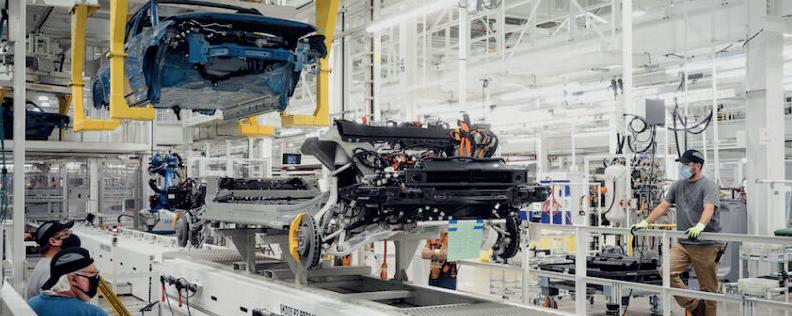
Rivian founder RJ Scaringe said: “We’ve decided to pause discussions with Mercedes-Benz Vans regarding the Memorandum of Understanding we signed earlier this year for joint production of electric vans in Europe. As we evaluate growth opportunities, we pursue the best risk-adjusted returns on our capital investments.
“At this point in time we believe focusing on our consumer business, as well as our existing
commercial business, represent the most attractive near-term opportunities to maximise value for Rivian.”
Mercedes-Benz and Rivian signed a Memorandum of Understanding (MoU) in September for the production of bespoke large electric vans, with the aim of building an all-new electriconly production facility leveraging an existing Mercedes-Benz site in Central/Eastern Europe.
SIEMENS and OSPREY to install 1,500 EV chargers over next four years
Rivian will instead focus on its existing portfolio, which consists of the R1T truck and R1S SUV, as well as its commercial van for Amazon.
However, Scaringe did not rule out working with Mercedes-Benz again in the future: “We share the same goal as Mercedes-Benz Vans, to help the world transition to electric vehicles, and we look forward to exploring opportunities with them at a more appropriate time for Rivian.”
Siemens and Osprey Charging have joined forces to help accelerate the delivery of new public electric vehicle charging sites.
The agreement is designed to help meet the significant ongoing demand for public EV charging options as well as address the specific need for new publicly available EV infrastructure across the country.
As part of the collaboration, Siemens will become a preferred supplier of end-end meter operator (MOP) services and commission and install meters at each EV charge point at Osprey Charging Networks’ sites up and down the country. The meters deliver power to the charging units and record electricity usage for accurate billing, reporting and recharging by the CPO.
Ian Johnston, CEO of Osprey Charging, said: “We have an aggressive roll-out plan to more than double the size of our network to over 1,000 chargepoints in 2023, so it is imperative that we are able to act quickly to deliver the EV charging infrastructure required to meet public demand. It’s no small feat from an infrastructure perspective and we are focussed on how to support this delivery at pace.
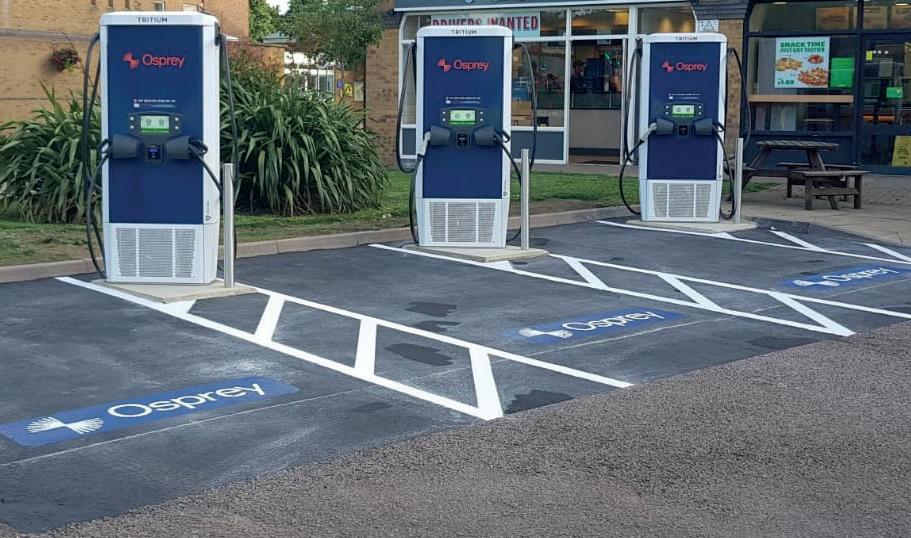
EV NEWS 6
Rivian has put plans to produce electric vans with MercedesBenz on hold as it prioritises its existing business.
in Sports (GSBS) annual report
The study analysed more than 50 elite sports organisations of more than 300 invited to take part, including FIFA, Formula 1 and the NFL, and Formula E achieved a recordbreaking benchmark score to win the honour.

Pricing of the Range Rover Classic will be £230,000 plus VAT and the donor vehicle, meanwhile the Land Rover Defender will be £185,000, plus VAT and donor vehicle.

Australian express freight company, TEAM GLOBAL EXPRESS has placed an order for 36
This is Volvo’s largest electric truck order to date in Australia. The trucks will hit the streets of Sydney during the first quarter of 2023. BONNET
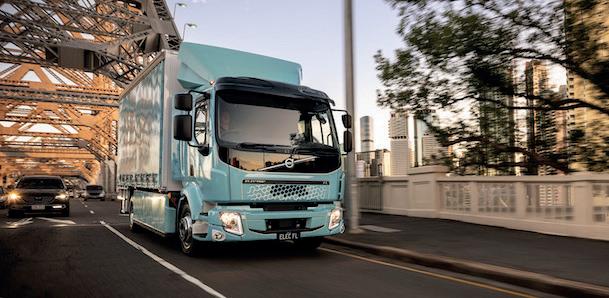
InstaVolt is to add 16 new chargers to its Banbury hub to become one of the largest charging hubs in the UK.
Britain will run out of mechanics to service the growing number of EVs on its roads by the end of the decade, a think-tank has warned.
Marks & Spencer and bp pulse have signed an agreement to bring highspeed EV charge points to the M&S stores across the UK.
MFG EV Power currently operates 51 ultrarapid charging hubs across the UK, with plans to install a further 3,000+ ultra-rapid chargers with speeds of 150kW to 300kW across its 900 locations in the UK by 2030. As its network grows, all new chargers will also be made available on Bonnet as they are installed.

EV battery pack firm Hyperbat has sealed a multi-million-pound contract to supply batteries to Lotus for its new all-electric Evija.
MG Motor UK’s new all-electric MG4 hatchback has achieved the maximum five-star Euro NCAP safety rating.
7 EV NEWS
NEWS IN BRIEF
EVERRATI has expanded its lineup with zero-emission versions of the RANGE ROVER CLASSIC and LAND ROVER DEFENDER
FORMULA E has been ranked as the ‘Best Total Performer’ in the 2022 Global Sustainability Benchmark
VOLVO electric trucks
the charging network MFG EV POWER
to access
app
has announced that
is now available
through its
is ready



is ready
Back in December 2022, just two weeks before pre-season testing, the Nissan Formula E Team unveiled its new look for Gen3. Coated in the traditional red and white of Nissan, the car is also draped in cherry blossom, or ‘sakura’ to give it the true Japanese name.

“Our new livery celebrates our Japanese heritage and I’m certain that the design will stand out on the track like never before,” said Ashwani Gupta, Nissan’s Chief Operating Officer. It is a truly striking design, and although the new livery will help Nissan stand out on the grid, the team will be hoping to win more than ‘Best Dressed’ in Season 9.
“Formula E represents the pinnacle of EV technology, and we are confident this upcoming, next-generation series will deliver innovation and excitement on and off the track,” said Guillaume Cartier, Chairperson, Nissan AMIEO (Africa, Middle East, India, Europe and Oceania).
“With more than half of the races taking place within our diverse AMIEO region, our ability to implement road-to-track and tack-to-road knowledge exchange will directly contribute to the development of our electrified technologies and electric powertrains to deliver the best for our customers.”
DRIVING FORCE
Leading the charge this year is a refreshed lineup consisting of Norman Nato, former Formula E race winner and Jaguar TCS Racing’s reserve driver from last year, and 2022 Super Formula runner-up Sacha Fenestraz.

The pair replace the outgoing Max Guenther and Seb Buemi, who endured a difficult season last year, finishing a lowly ninth out of just eleven teams on the grid. It was time for change, and the start of Gen3 was the perfect time for an overhaul.
“This season is a new beginning for me, and one I’m extremely excited for,” Nato said. “Now, we have to keep focusing on getting ready for the season ahead, developing the car, and building relationships within the team so we are prepared for the first race in Mexico. It’s a good opportunity for us to show what we’re capable of as drivers. We have a lot of pressure, but it’s good pressure.”
With limited experience in Formula E, it is an exciting time for Nato’s partner, the FrenchArgentinian Fenestraz, who made his debut in the season finale last year, standing in for Antonio Giovinazzi in Seoul.
” “
NORMAN NATO (L) AND SACHA FENESTRAZ WILL LEAD NISSAN FORMULA E TEAM INTO GEN3
Formula E represents the pinnacle of EV technology, and we are confident this upcoming, next-generation series will deliver innovation and excitement on and off the track.
With a permanent seat on the grid, Fenestraz is confident Nissan can improve on last year’s performance. “It’s going to be a great season for us,” he said at Nissan’s Gen3 unveiling in Madrid.



“It’s a whole new team with new expectations, and I’m really looking forward to sharing the season with Nissan and with Norman.
“It will be a big step forward in my career, to move up into a World Championship for the first time and to be competing at such a high level against some of the best drivers in the world. It’s going to be a different challenge for me as it will be my first season in an all-electric car. I’m excited to compete in this championship as street circuits are my favourite, with high risks and no room for errors. As a rookie in a new format, there is a lot of preparation to do and plenty to learn! I’ve been dreaming of this moment for a very long time, and I am very grateful to Nissan for this opportunity. I can’t wait to get started and I’ll do everything to perform as best as I can.”




FORMULA E IS BACK
After four months off, the ABB FIA Formula E World Championship returns this month for Season 9 to mark the start of a new generation.
The wait for Formula E’s ‘Gen3’ is finally over as the series gets set for a brand new era of racing, featuring the fastest, lightest, most powerful and efficient electric race car ever built. Season 9 kicks off its biggest campaign ever later this month, with Round 1 in Mexico City on 14 January, before heading off to new locations such as India, Cape Town and Sao Paulo.

As well as new locations, there are also new driver lineups, new sporting regulations and a brand-new car!
THE GEN3 CAR
The Gen3 is the world’s first race car designed and optimised specifically for street racing, with the car slightly smaller and narrower than
the previous generation. However, the main differences lie beneath the surface.
This is the fastest Formula E car yet, with a top speed of over 200mph thanks to both front and rear powertrains, a first for the series. A new front powertrain adds 250kW to the 350kW at the rear, more than doubling the regenerative capability of the current Gen2 to a total of 600kW.
FORMULA E
More than 40% of the energy used within a race will be produced by regenerative braking, making this the most efficient formula racing car ever. The batteries of the vehicle are also among the most advanced, sustainable batteries ever made consisting of sustainably-sourced minerals while battery cells will be reused and recycled at end of life.

It will also have around 95% power efficiency from an electric motor delivering up to 350kW of power (470BHP), compared to approximately 40% for an internal combustion engine.
NEW TEAMS, NEW DRIVERS
It McLaren and Maserati are new to the Formula E grid next season. They will join some of the biggest names in motorsport including Jaguar, Porsche and Nissan among the 11 teams and 22 drivers competing for world titles.
Reigning Formula E World Champion Stoffel Vandoorne will be representing DS Penske this year, following Mercedes’ exit from the series. Vandoorne will race alongside Jean-Éric Vergne, with Antonio Felix da Costa making the switch to Porsche, where he will team up with Pascal Werhlein.
McLaren’s first season in Formula E will be fronted by former Audi driver René Rast and rookie Jake Hughes, whilst Maserati have recruited Max Günther from Nissan and Edoardo Mortara, who came close to claiming the title last year.
Robin Frijns has left Envision Racing for ABT Sportsline, where he will partner Nico Mueller. Seb Buemi has made the switch from Nissan to replace Frijns at Envision, teaming up with Nick Cassidy.
Avalanche Andretti’s Jake Dennis will be partnered by André Lotterer this year, with the German moving from Porsche.
Sam Bird and Mitch Evans will continue to lead the way for Jaguar TCS Racing; Norman Nato and Sacha Fenestraz come in for Nissan; Oliver Rowland and Lucas di Grassi team up for Mahindra; and Sergio Sette Câmara and Dan Ticktum will fly the flag for NIO 333.
15
THIS IS THE FASTEST FORMULA E CAR YET, WITH A TOP SPEED OF OVER 200MPH... ” “
R4: HYDERABAD, INDIA FEB 11
R5: CAPE TOWN, SOUTH AFRICA FEB 25
R6: SÃO PAULO, BRAZIL MAR 25
R7: BERLIN, GERMANY APR 22
R8: BERLIN, GERMANY APR 23
R9: MONACO, MONACO MAY 6
R10: JAKARTA, INDONESIA JUN 3
R11: JAKARTA, INDONESIA JUN 4
R12: PORTLAND, USA JUN 24
R13: ROME, ITALY JUL 15
R14: ROME, ITALY JUL 16
R15: LONDON, ENGLAND JUL 29 R16: LONDON, ENGLAND JUL 30
SPORTING REGULATIONS
The FIA has confirmed a series of updates to the sporting regulations for Season 9 of the ABB FIA Formula E World Championship.
Races will run over laps instead of a set time period this year. To maintain consistency with the switch to laps, Safety Car and Full Course Yellow interruptions to racing will now be compensated by added laps, replacing the additional racing time feature.

Formula E and the FIA have also been working with strategic technology partners to develop pioneering battery and charging capabilities that will allow the new smaller, faster and lighter Gen3 cars to receive a boost of energy during the race.

This collaboration has resulted in the development of a battery capable of receiving 4kWh of energy inside 30 seconds – the most advanced EV battery in the world today – delivered by a 600kW booster.
A mandatory 30-second Attack Charge stop during a pre-determined period in the race will unlock two enhanced Attack Mode periods to be deployed later in the race where the power output of the Gen3 race cars will increase from 300kW to 350kW.

Attack Charge is set to be trialled at select races later in Season 9. The existing Attack Mode format of a temporary power boost activated by drivers during the race will be maintained in races where Attack Charge is not implemented. Fanboost has been discontinued and will not feature in Season 9.
This year, every team must also complete at least two Free Practice 1 sessions during the season with a driver who has never previously competed in the championship. The goal is to give upand-coming drivers the chance to experience the unique qualities of Formula E racing and to contribute to the progress of the team.
FORMULA E 16
ABB FIA FORMULA E WORLD CHAMPIONSHIP SEASON 9 CALENDAR
R1: MEXICO CITY, MEXICO JAN 14 R2: DIRIYAH, SAUDI ARABIA, JAN 27 R3: DIRIYAH, SAUDI ARABIA JAN 28
SEASON 9 CALENDAR
Season 9 of the ABB FIA Formula E World Championship gets underway on 14th January with Round 1 taking place in Mexico City, before the traditional double-header in Diriyah, Saudi Arabia later this month.



The series will then head to Hyderabad, India for the very first time in February, followed by another first for the Championship with the Cape Town E-Prix for Round 5. Sao Paulo will host Round 6 on 25th March, before the Berlin E-Prix double-header.
Formula E then heads back to the iconic principality of Monaco for Round 9 in April, with Round 10 now set to take place in Portland, USA for the first time ever. Jakarta will host Rounds 11 and 12, with the destination for Round 13 also yet to be revealed.
As the season turns onto the home straight, Rounds 14 and 15 will take place in the Eternal City of Rome, before the season finale in London on July 29th and 30th.
17 FORMULA E
DRIVER LINEUPS FOR SEASON 9 ABT SPORTSLINE: ROBIN FRIJNS, NICO MUELLER AVALANCHE ANDRETTI FORMULA E: JAKE DENNIS, ANDRÉ LOTTERER DS PENSKE: STOFFEL VANDOORNE, JEAN-ÉRIC VERGNE ENVISION RACING: SEBASTIEN BUEMI, NICK CASSIDY JAGUAR TCS RACING: SAM BIRD, MITCH EVANS MAHINDRA RACING: OLIVER ROWLAND, LUCAS DI GRASSI MASERATI MSG RACING: EDOARDO MORTARA, MAX GÜNTHER NEOM MCLAREN FORMULA E TEAM: RENÉ RAST, JAKE HUGHES NIO 333 RACING: SERGIO SÊTTE CAMARA, DAN TICKTUM NISSAN FORMULA E TEAM: NORMAN NATO, SACHA FENESTRAZ
what will we see in 2023

18
EV PREDICTIONS
As we turn the corner into 2023, major players from within the EV industry share their thoughts on what this year might have to offer!
Why solar-compatible EV chargers are the


tech to watch in 2023
Jordan Brompton, myenergi
“While solar is one of the most cost-effective iways to generate decentralised power, its Achilles heel remains. After all, most household energy is used in the evenings, but solar energy is generated during the day. Unless you have a comprehensive storage solution, like our all-new libbi smart battery, it’s most likely that you’ll export sustainable power at periods of low consumption and buy back mains supply at a more expensive rate when you need it.

“With the transition to electrification continuing at pace and the rate of solar installs rocketing, we believe that everyone who either has solar PV – or has the opportunity to install it in the future – should consider investing in a solar-compatible charger. They’re the perfect, futureproof solution to maximise self-consumption.
“The cost of grid generation is well outside the control of homeowners, which makes it the perfect time to become more independent. With concerns about ongoing price hikes, self-generation, energy independence and smart eco-smart technologies can provide the solution.”
High-efficiency inverters lead the
‘third wave’ of
electrification
Steve Lambert, Head of Electrification, McLaren

“We believe that high-efficiency inverters that offer higher switching frequencies and unparalleled controllability will play an important part in the transition to electrification, because they add character to vehicles thanks to improvements in packaging and performance.
“We see silicon carbide (SiC) as leading the ‘third wave’ of electrification. The first wave involved early pioneers of technology, and we’re currently in the second wave where EVs have broken through to the mainstream. The third stage is efficiency and will see inverter technology rapidly adopt SiC semiconductors, especially in 800V architectures and vehicles that need longer range where efficient power electronics are key.
“Efficiency is going to be the battleground. It’s how brands will compete with one another. If you’re more
efficient, you can have a better vehicle. It’s going to be lighter. It’s going to get a better range from the energy you have. It will be quicker to recharge

Applied
because you need less energy for a given distance. When it comes to efficiency, silicon carbide excels, and will be the defining feature of the third wave.”
19 EV PREDICTIONS
A need to improve customer and driver experience
Philip Nothard, Insight and Strategy Director, Cox Automotive

“We are observing the transition towards an EV-dominated new vehicle market share in the UK, European markets, and globally; however, there remain obstacles to overcome. The rising raw material costs are bumping up retail prices, impacting and dissuading consumers from purchasing the sustainable vehicle alternative. Alongside the energy crises we currently find ourselves in, reports are emerging that the TCO (Total Cost of Ownership), compared to their equivalent combustion counterpart, is under question. Unprecedentedly rising raw material costs have underpinned the eversoaring battery prices, and even whether there will be a sufficient supply of raw materials to satisfy the demand remains to be seen.
“With the recent Autumn Statement announcement, scrapping the tax exemption on electric vehicles raises their cost of ownership even further. Furthermore, it introduces additional concern that this will hinder the industry’s recovery efforts as it returns from the impact of the pandemic,

Brexit and spiralling energy costs. The exemption also risks further dampening already weak consumer spending and confidence, providing another obstacle to growth and the transition to electrification. There is clear evidence that the energy crisis is slowing this transition, and we anticipate this will only accelerate. The supply-anddemand situation for EVs in the used sector remains quite volatile, and their low running costs are a key attractor for consumers, so this is probably a retrograde move.
“We have come a long way in times of uncertainty, with many known unknowns and the need to be agile in a period of volatility. The sector will need to improve customer and driver experience through convenience and efficiencies as we progress towards mass market adoption.”

EV PREDICTIONS 20
The year for vehicle-to-grid?

James
Eaton, CEO and founder, IONETIC

“Next year I expect to hear more about vehicle-to-grid, where an EV’s battery can play an active role in powering your home and the grid. Currently, the Nissan Leaf is one of the few EVs on the market that allows this, but a change in legislation would make it more common and likely prompt larger EV manufacturers such as Tesla into enabling it. I think next year V2G legislation will either arrive or a date will be announced for when it will arrive.
“As a company specialising in EV battery pack technology with a close eye on carbon emissions, we always advise our clients to build
vehicles with V2G capability. It’s a win for the manufacturer, consumer, and the environment. EVs parked in garages or driveways plugged into the mains can become a key part of the grid serving as ‘peak shavers’working to supply power to the home when demand is high. Not only this but consumers could also sell unused power back to the grid; effectively making money back from their EVs.”

21 EV PREDICTIONS
Smart charging, accessibility and local authorities
Lauren
Pamma,
Programme
“2022 was an exceptional year for EV adoption in the UK, but it didn’t come without challenges, particularly the energy price crisis.
“Central to driving down costs is smart charging. In 2023, smart charging will become more important than ever before to not only balance peak grid, but drive down prices. This, alongside the REMA (Review of Electricity Market Arrangements) consultation, would see electricity prices fall next year.
“Local Authorities are also set to have a large injection of finance early next year through the launch of the LEVI fund, to deliver significant charging infrastructure investment and deployment. When public funding for charging infrastructure comes to an end, we will need to see private sector investment increase to continue the roll-out of charging infrastructure.
Director,

Coalition for the Decarbonisation of Road Transport
“Supply of used vehicles is set to rapidly increase going into next year. Unless we get the second-hand EV market up and running in full force, and give consumers confidence to acquire a used EV, the increase in supply will not be met by an increase in demand. Currently, we are witnessing early signs of divergence, putting downward pressure on used car prices.
“Accessibility will also remain a key area of focus for the industry, particularly charge point operators. Earlier this year, industry groups and other bodies, such as Motability, worked alongside Government to publish a specification for the accessibility of charge points, to ensure that no one is left behind in the EV transition. This should create a step change in accessibility for chargers from next year.”
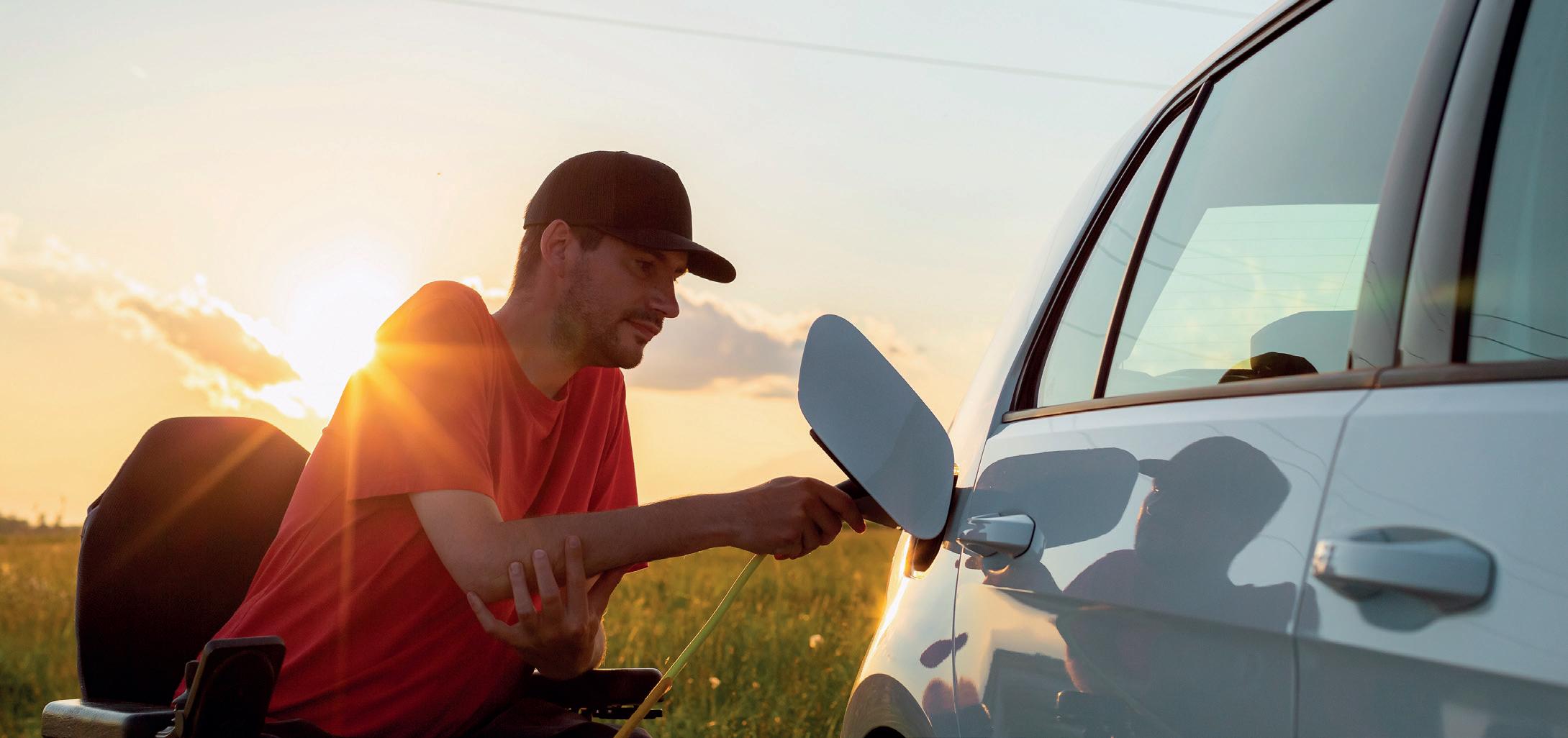
EV PREDICTIONS 22
Eurorepar Car Service More choice for motorists
“The government’s petrol and diesel ban announcement in 2020 was the catalyst for many of the UK’s garage owners to start thinking about preparing for the future and investing in electric vehicle training and equipment. However, adoption of these new skills and technologies has still been relatively slow, with operators choosing to bide their time and scope out the market before taking the plunge.
“This is borne out in industry data, which shows that under half of independent garages still do not offer any electric vehicle-related services. Electric vehicle owners have therefore been presented with a limited choice of specialists to visit for repair and maintenance work.

“In 2023, we expect to see the picture shift, as a rising number of garages will seek to capitalise on the groundswell of electric vehicles entering the aftermarket. Naturally, this will bring increased choice for consumers, as more independent operators join the fray to compete with franchised dealers. Historically, this kind of competition has only been a good thing for motorists.
“With the electric vehicle repair market set to grow, we also expect to see increased uptake of training courses and investment in skills next year. And quite right, too – working on high voltage electric vehicles is a dangerous and highly skilled job. Motorists should therefore be vigilant when selecting a garage, opting only for reputable, trustworthy businesses with the requisite qualifications.
Electric vehicles and fleets in 2023



“The definition of sustainability will continue to broaden with economic sustainability coming to the fore in recessionary times. Until the supply chain improves; fleets are going to have to run vehicles for more years than planned. There will be more focus on how data can help reduce the carbon footprint of these vehicles, increase vehicle utilisation and reduce maintenance requirements. The marriage of EV and ICE vehicles is here for the foreseeable future and data is the key to making it a harmonious one.
“5-minute EV charging and innovation in battery management will accelerate—from battery swapping to off-street charging. Traditionally, EV batteries took some time to charge, but a potential solution to this problem is to develop new battery technologies that can be charged more quickly without sacrificing their energy density. This could be achieved through the use of advanced materials and design techniques that allow for faster charging and improved heat
management. Innovation in battery management is also playing a key role in improving the charging speed and efficiency of EVs. Battery management systems monitor and control the individual cells in a battery pack to ensure that they are charged and discharged safely and efficiently - this can help to extend the lifespan of the battery by preventing overcharging and preventing the formation of defects in the battery cells.
“Charging infrastructure improvements from additional government investments, and campaigns for tax reductions. We’ll see new technologies, such as fast-charging systems, will be installed across more locations, and at a better cost to users. We predict to see a bigger focus on EVs in the B2B market, from ecommerce and food deliveries to public sector fleets. Alongside this, government incentives for businesses will continue to be vital to driving EV adoption at scale.”
23 EV PREDICTIONS
David Savage, VP, UK & Ireland, Getoab
SCOTLAND’S ELECTRIC 4X4 MUNRO VEHICLES
Designed, engineered, and built in Britain, Munro’s first vehicle is the first light vehicle to enter production in Scotland in more than four decades. Like the Scottish mountains the brand is named after, the Munro has been conceived to last a lifetime, with the company determined to engineer the ‘world’s most capable all-electric 4X4’ that can offer its owners 50 years of unwavering service.
Born off-road, born electric
The company was founded in 2019 by Russell Peterson and Ross Anderson, with Peterson assuming the CEO role and Anderson appointed Head of Powertrain. The idea, which is named after a Scottish mountain that exceeds a height of 3000 feet, came to them during an off-road camping trip in the Highlands.
“We had already taken measures to reduce our own environmental footprints and had a lot of experience driving our own EV, and got quite used to the instant torque delivery,” recalls Peterson.
“But the off-roader we were driving through the Highlands was combustion-engined, and it was really struggling on the steep climbs. So, we
were musing how much better it would be with an electric motor.”
“On the return journey, we stopped at a café in Braemar, where a bank of 50kW rapid chargers were sitting empty and unused. Parked up nearby was a large group of combustion-engined safari adventure 4x4s of a type that are no longer manufactured and will have to be replaced eventually.
“It dawned on us that there was a gap in the market for an electric-powered, four-wheel-drive, utilitarian workhorse. We envisioned a vehicle with ultimate, go-anywhere, off-road ability, unrestricted by roadderived underpinnings that limit the all-terrain ability of vehicles such as the 4x4 pick-up trucks that have come to dominate the market.”

MUNRO VEHICLES 24
Meet Munro Vehicles –The Scottish automotive brand that has revealed its first fully-electric 4X4, the Munro Mk 1.
Power and durability
The Munro is offered with a choice of two electric motors, 220kW and 280kW, along with the option of two battery packs, 61kWh and 82kWh, affording an optimum range of up 190 miles This allows the Munro to operate off-road for up to 16 hours on a single battery charge.
The vehicle’s battery pack comprises 35 state-of-the-art Lithium NMC battery modules mounted in three heavy-duty aluminium boxes underneath the vehicle. This arrangement ensures it is quick, convenient, and inexpensive to replace individual battery modules if required. A fully integrated heat pumpbased thermal management system bolsters efficiency, and the Munro’s battery pack is guaranteed to deliver 80 per cent of its original energy capacity for at least eight years and 100,000 miles.
“With your average electric vehicle, the battery is designed to last the life of the car, so in most cases, customers will never have to worry about replacing it. But because the Munro is engineered to last several decades, we will either recondition or replace the battery pack for customers when the time comes. This has the added benefit of guaranteeing the future value of our customers’ vehicles,” explains Anderson. “We will partner with companies specialising in reuse and recycling to recoup the residual
value of the battery pack, which will enable us to fit the latest battery technology at a reasonable cost.”
The Munro is offered with a choice of two AC charging options, 7kW to replenish the battery overnight, and 22 kW, which provides a full charge in around three and a half hours. An industry-standard DC CCS charger is also provided, enabling the battery to be replenished in just over 30 minutes.
Every Munro is geared for torque, with a top speed of 80mph, and the 280kW Performance version can surge to 62mph in a mere 4.9 seconds. However, the focus of the vehicle is firmly on utility, workability, and superior off-road drivability, as Anderson reiterates.
“Peak torque of 700Nm is available up to 50mph, which ensures excellent response off-road. It also means the Munro can effortlessly tow a braked trailer weight of up to 3500kg. Whether it’s a mini digger, a power generator or livestock that needs transporting, the Munro makes light work of it.”
At home off-road
”The best way to drive off-road is to ensure that the same amount of torque is delivered to each wheel and that all the wheels spin at the same speed,” asserts Peterson. “And no matter how clever your computer is, you’re still going to have problems if you’ve got a split driveline in the vehicle.
“And the other thing is many electric SUVs and pick-ups on the market tout a big headline figure like 600 horsepower. But when you think about it, it’s 400 horsepower at the back wheels and 200 at the front. And as soon as the vehicle loses traction at the back wheels, you’ve only got the power of the front motor to pull you out. So that’s one of the reasons we decided to fit one big electric motor in the middle and power all the wheels using a mechanical driveline.”
The vehicle’s off-road prowess is further enhanced by 480mm ground clearance, and the ability to wade through water up to a depth of 800mm. Equally impressive 84- and 51-degree approach and departure angles, plus a 148-degree ramp breakover angle, give the Munro the ability to cope effortlessly with steep hills, heavily rutted terrain, craters and boulders.
The Munro sits on a galvanised steel ladder chassis, designed, engineered, and built at the company’s HQ. Constructed with 5mm thick steel – compared with 1.5mm thick steel used in many 4X4s – the Munro’s chassis has been developed to provide the ultimate combination of strength, robustness, and ease of repairability.



“The engineering is unashamedly agricultural in nature,” explains Peterson, who comes from a farming background and ran his own contracting business. “Some people see the term agricultural as potentially derogatory, but at Munro, we certainly don’t.
“Agricultural vehicles feature some of the most sophisticated technology you can imagine. But above all, they are engineered to do the job, no matter how much punishment they soak up, and to keep doing it year after year. The Munro has been built to the most robust standards possible and to be fully operational in 30, 40, 50 years’ time.”
Priced from £49,995 (excluding VAT) in five-door, five-seat, 130-inch wheelbase Utility guise, Munro has already received deposits for several Munro MK 1s that it will hand-build. Orders have come from locations across the globe including the UK, Switzerland, St Lucia, and Dubai. Several presale agreements have been reached with fleet operators in key industries.
Munro Vehicles will build 50 vehicles in 2023 before transitioning to a new purpose-built site near Glasgow in 2024. With the creation of 300 new jobs, production will be ramped up to 250 vehicles per year with a strategic roadmap in place to deliver 2,500 units annually by 2027.

25 MUNRO
VEHICLES
FORD MUSTANG MACH-E X REVIEW
IT THE BEST MUSTANG YOU CAN BUY?!
BY CHARLIE ATKINSON
The Ford Mustang Mach-E Extended Range AWD model sits in the middle of the manufacturer’s electric ‘Mach-E’ lineup, alongside its RWD ‘X’ counterpart and just behind the top of the range GT spec.
As the name would suggest, the Mach-E X model promises and extended range over the standard, entry level model, as well as improved performance and a few other extras. But at the cost of an extra £15,000, is it really worth it? Find out in our in-depth review of the Ford Mustang Mach-E X.
DESIGN AND INTERIOR
The main differences between the X and other specs are in the batteries, and so the design of this car is the same across the board, besides from some little ‘X’ detailing’s on the logo and different wheel trims.
The car is a well-dressed SUV styled as a sleek coupé thanks to the clever two-toning on the roof. Deceptively large, the Mustang Mach-E does a good job of retaining the DNA of the pony car’s iconic look, whilst making it fit for the modern age of electrification.
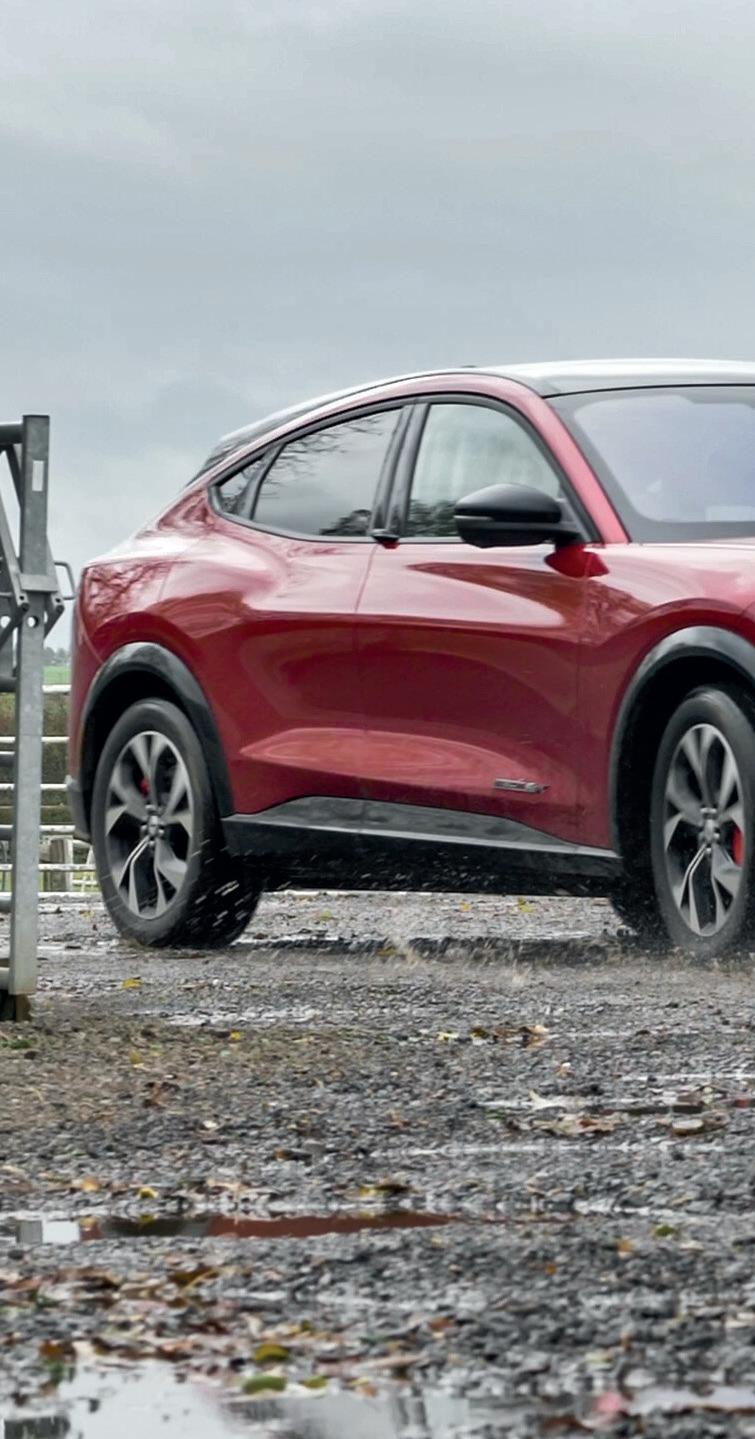
The grille is covered but retains the traditional Mustang logo like its ancestors, and other features such as the headlights, brake lights and the bodywork are different enough to make the Mach-E stand out on its own, whilst still tipping its cap to its lineage.
Whilst the exterior still pays homage to the Mustangs of old, the Mach-E’s interior has instead adopted the customary EV approach, with an impressive 15.5” infotainment screen that dominates the inside of the car.
The inside of the car goes someway in justifying the price tag and indeed the ‘Premium’ label of the car, with plush synthetic leather upholstery and other, modern touches such as wireless charging for your phone.
The Premium AWD model also offers a panoramic sunroof, and there is plenty of room in the back, with a decent size boot with 402L. There is also a handy frunk for you to store all your charging cables, too.
STANDARD MODEL VS X VS GT
The standard model of the Mach-E offers a WLTP range of 273 miles, in comparison to this Premium AWD models’ 341 mile range. There is also a Premium RWD extended range model, which offers a greater range of 372 miles, but that compromises on certain areas of performance. The GT version offers a range of just over 300 miles, too.
In terms of performance, the AWD option offers a significant improvement over the standard model, with a 0-60 time that goes down from 6.9 seconds to 5.8 seconds. It also packs 351ps to the standard ‘Select’ models 269, as well as an upgrade in torque, from 430Nm to 580Nm. It might offer a better range and better performance, but does this translate to the real world?
FORD MUSTANG MACH-E X 26
IS
DRIVING
In our real world test, we reviewed the Mustang Mach-E X on a crisp, autumn morning in early November, and the results were surprising.
As part of the test, I set off from my home fully-charged, with the range reading 248 miles – A noticeable drop-off from the WLTP range of 341 miles. In fact, this is also someway short of the Standard models promised 273 miles. Even when taking the conditions into consideration (with it being slightly chilly outside) it is still disappointing for a car that claims to be an ‘extended range’ model.
When it comes to performance, there isn’t too much difference there, either. This is not to say that the Mach-E X is underwhelming to drive – It is still a joy to be behind the wheel of this thing. However, there is no noticeable improvement over the Select model. It feels as agile and lively as ever, but nothing to make you get overly excited about. It may have shaved just over a second off the 0-60 time, but you will very rarely launch this car from a standing start on a day-to-day basis.
Having driven both cars for an extended period of time, it was hard to spot any great differences in performance. When you put your foot down on an empty stretch of road, you still get that smile on your face, but it is no bigger than the one you’ll have when behind the wheel of the Select model. This begs the question then, is it worth it?
VERDICT
In terms of price, those extra miles and saving that extra second going 0-60 does come at a bit of a price. Standard models for the Mach-E start from just over £50,000, whereas this Premium AWD model is £15,000 more expensive, with prices starting from £65,400.
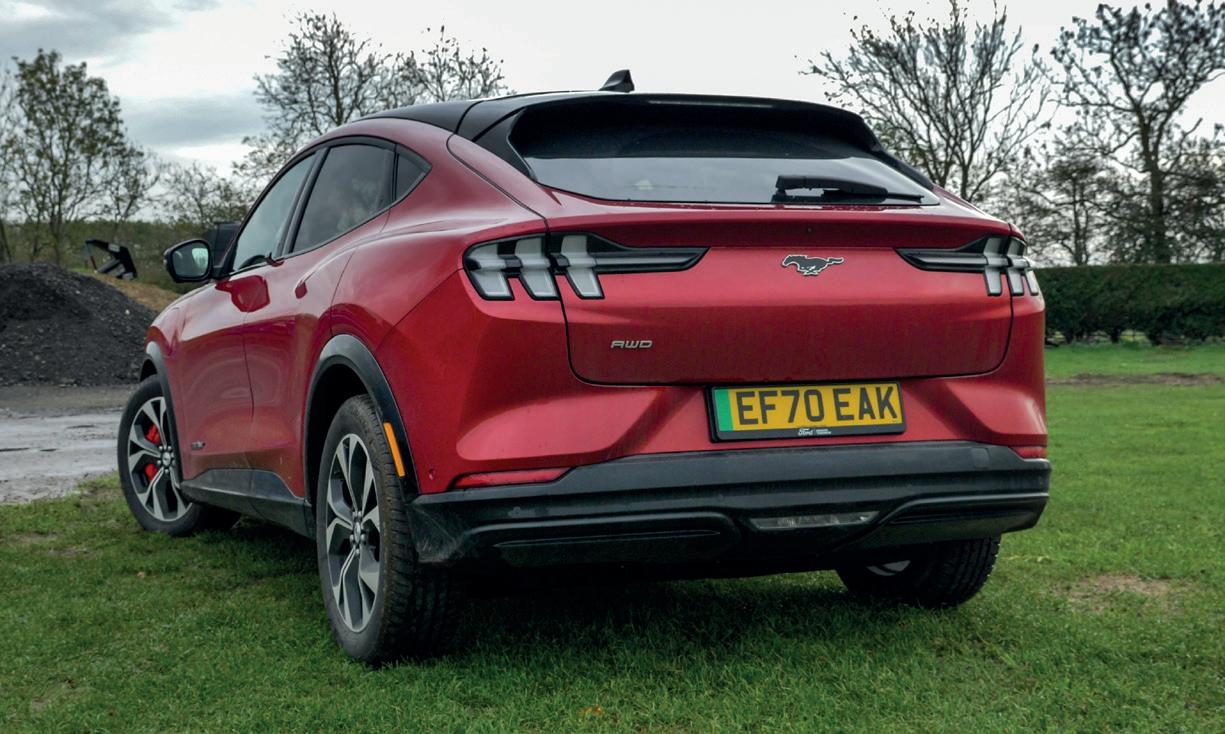


Is the extra bit of range really worth it? Even when it’s unlikely that you will achieve the actual WLTP range of 341 miles? My answer is probably not. That is not to say that the Ford Mustang Mach-E X is a bad car – far from it. It is an amazing car to drive, and it boasts one of the most unique designs across the entire EV market.
The issues lie with the price. There still a decent range on the standard model and the drop off in performance isn’t too severe. If you did want to make the step up for that extra range, then I’d probably ecommend saving a bit of money and going for the rear-wheel-drive version. If you really want to splash the cash and guarantee that brain-melting performance, then it will be worth stepping up to the GT version. However, whichever model you choose, you’ll be in for a right treat.
27 FORD
MUSTANG MACH-E X
TOP TEN EV MOMENTS OF 2022
As the EV movement continues to accelerate into 2023, we take a look back over some of the most memorable ‘EV moments’ from last year!

TOP TEN 28
LONDON TO BRIGHTON EV RALLY


Following the success off its inaugural event in 2021, the second London to Brighton Electric Vehicle Rally took place on Saturday 25 June.

Over 70 different electric vehicles lined the seafront as the rally entries arrived on Madeira Drive, with solar- powered cars, self-builds, e-bikes and even an electric plane following the 59-mile route to the city.

Organised in partnership with electric bus company The Big Lemon and sponsored by




EDF, Britain’s biggest generator of zero carbon electricity, the second annual event left Parliament Square shortly after 8am to Brighton Beach. All participants stopped at Ifield College, Crawley for a breakfast and team photo before continuing to Brighton’s Palace Pier and the finish line on Madeira Drive.
Tom Druitt, one of the event organisers, stated: “The rally was a fantastic day and a huge success. Participants and spectators all had a
great time and we enjoyed wonderful support from our sponsors EDF, JLC Group, the RAC, University of Brighton, Hendy Group, the Fully Charged Show and 3ti. We had a fabulous launch event in London on the banks of the Thames, and a brilliant welcome by Ifield Community College in Crawley where we had a pit-stop at half time. Madeira Drive hosted everything from solar car parking, solar cars, EDF’s renewable technologies and even a flyby from a Nebo Pipistrel electric plane – the only one in existence in the UK.”
RECORD ATTENDANCE AT RACE OF REMEMBRANCE
The 2022 Race of Remembrance, Mission Motorsport’s flagship event, delivered in conjunction with BRSCC at the Anglesey Circuit Trac Mon, played host this year to 55 race teams, the highest number of entries ever to compete in the eight-year history of the event.

Over the course of Remembrance weekend, Mission Motorsport supported its largest cohort of wounded, injured and sick Service Personnel and Veterans, including those from Operation
Motorsport, its sister charity from America and Canada who joined after a covid- induced break of two years.
Over 100 beneficiaries participated across the Remembrance weekend, including 12 US and Canadian veterans thanks to sister organisation Operation Motorsport, and activites ranged from the Karting Race of Remembrance at Thruxton to a Remembrance Service held at Brands Hatch.
James Cameron, CEO of Mission Motorsport, said: “Race of Remembrance is British motorsport’s way of marking Remembrance weekend, and to celebrate the intersection of motorsport and the armed forces communities. Using motorsport as a hook, we’re able to support those who find this time of year incredibly difficult, to get them engaged and, for some, we’re enabling them to attend a Service of Remembrance when in previous years they haven’t been able.”

AUTOMOBILI PININFARINA CONFIRMS RECORDBREAKING BATTISTA PERFORMANCE AT UAE DEBUT
Back in November, luxury Italian carmaker Automobili Pininfarina’s Battista hyper GT set record-breaking official acceleration and braking figures.
The pure-electric Battista’s unique launch control technology contributes to Formula 1 carbeating acceleration, with 0-60 mph achieved in
1.79s, 0-100 km/h completed in 1.86s, 0-120 mph executed in 4.49s and 0-200 km/h obliterated in just 4.79 seconds. Official tests also confirmed the Battista as the fastest braking EV in the world, completing 100-0 km/h in just 31 metres.



Automobili Pininfarina says its electric hyper GT is the most powerful Italian car ever made with

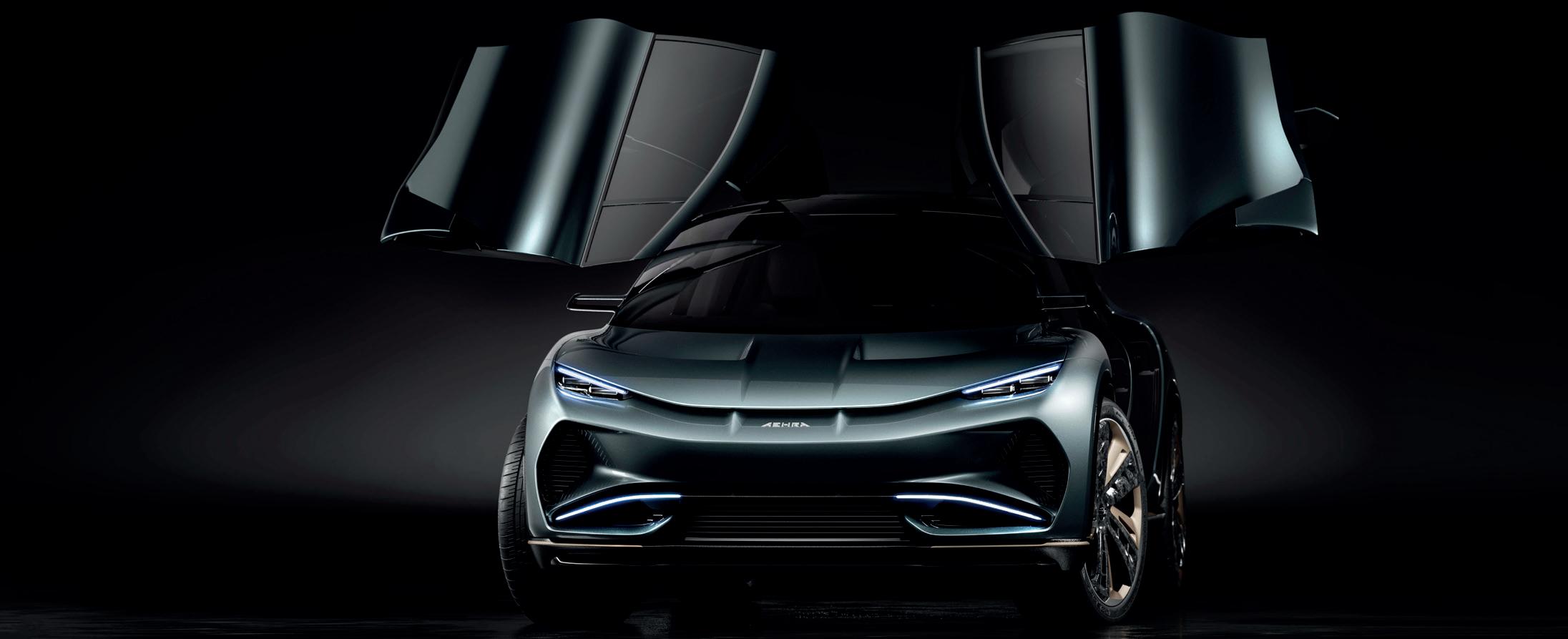
1,900 hp and 2,340 Nm of torque. The hyper GT has a top speed of 350 km/h, a WLTP range of up to 476 km and is priced from €2.2 million plus local taxes. Battista’s performance credentials were recorded and verified at Nardò, in Italy, as part of its global test and development programme earlier this year.

THE REVEAL OF AEHRA



At a swanky launch event in Milan last year, ultra-premium electric automotive brand AEHRA pulled the covers off its first ever electric vehicle and announced plans for its second EV.
AEHRA unveiled the design of its first vehicle, a supercar-inspired SUV with a 3m long wheelbase with a monobody architecture which maximizes space inside the cabin through a dramatically short front overhang. According to AEHRA’s bosses, the vehicle will target a range of around 500 miles, with a battery pack of up to 120kWh and “two or three” electric motors,
delivering between 550-600kW. The AEHRA is scheduled for deliveries in 2025, with an electric sedan, to be announced early next year.
“AEHRA was launched with a vision to unlock the full design potential afforded by cutting-edge EV platform technology in a manner not previously seen,” said Filippo Perini, AEHRA Head of Design. “AEHRA’s first SUV model seamlessly synthesizes the unmatched elegance of Italian design with the very best in global materials and engineering to deliver a shift-change across the entire customer journey.”
ELECTRIC CAR TO QATAR
To celebrate Wales reaching the World Cup for the first time since 1958, a group of supporters decided to make the trip from Cardiff to Doha in a fully electric MG4 EV.



Embarking on the 5,000-mile journey was a crew of four Welsh fans, including former Cardiff City player, Scott Young. The route would see the boys and their EV named Morris travel through
18 countries, all with the mission of raising awareness of sustainable issues.


Much like Wales’ performance in the World Cup, the boys’ journey came to an abrupt end on the last leg of their journey in Saudi Arabia. With right-hand cars not allowed in the country, the team had to leave Morris behind, but they did make it to Qatar in the end, with a little piece of the MG with them!
LEWIS HAMILTON’S X44 CLAIMS EXTREME E TITLE
X44 Vida Carbon Racing claimed its first Extreme E title by the narrowest of margins in an enthralling season finale in Uruguay.


X44 entered the final on Sunday with three of the top four teams in the championship standings missing out, including leaders and reigning champions Rosberg X Racing.


As their closest rivals watched on from the paddock, Sébastien Loeb and Cristina Gutiérrez secured the podium finish needed to take their maiden Extreme E title, just two points clear of RXR in the standings, having bagged a crucial five points from the Continental Traction Challenge in Qualifying 2.
The dramatic climax brought an end to RXR’s dominace in the series and capped off another incredible campaign of action and drama! Season 3 of Extreme E kicks off next month, with the first X-Prix opener taking place in Saudi Arabi on 11th – 12th March.
CAR TO QATAR FACEBOOK
ELECTRIC
RIMAC NEVERA HITS 258MPH TO BECOME WORLD’S FASTEST PRODUCTION ELECTRIC CAR
The Rimac Nevera has set a top speed of 258mph, making it the fastest electric production car in the world. The record-breaking feat follows on from the Nevera’s independently verified 8.582-second-quarter mile run in 2021, which made it the world’s fastest accelerating production car.

The Rimac team looked specifically for an oval with straights long enough to achieve the Nevera’s top speed, eventually settling on the Automotive Testing Papenburg track in Germany, with two 4km straights.



The Nevera is delivered to customers with a limited top speed of 219mph but can achieve the 258mph top speed in special customer events with the support from the Rimac team and under controlled conditions. The
Nevera was set into its top speed mode, creating an aerodynamic profile that balances drag and downforce to ensure stability at high speed. Fitted with road legal Michelin Cup 2R tires, and with the oversight of a Michelin technician to check their condition, the record-setting run got underway.
Miro Zrnčević, Rimac’s Chief Test and Development Driver, said: “To travel at 412kph, or 258mph, means travelling at a third of the speed of sound. I’ve driven Nevera since it first turned a wheel and to see the perfectly honed car that is today is a really emotional moment. The most important thing I have learned during the top-speed attempt is how composed and stable the car was – confirming that our aerodynamics and vehicle dynamics teams have done an amazing job.”
TEST DRIVING ELECTROGENIC’S PORSCHE 356 AT BICESTER HERITAGE

Back in June, we had the pleasure of test driving the fully electric Porsche 356 by EV conversion specialists, Electrogenic.

On a scorching day in June, EV Powered’s editor, Charlie Atkinson, got behind the wheel of the



Porsche and had a track at Bicester Heritage all to himself. Here, he was able to experience the 36kWh lithium-ion battery which replaced the Porsche’s original 1.6L flat-four engine, delivering 235Nm torque and a 0-60mph time of seven seconds.
Whilst the 356 has been catapulted into the 21st century with the electric motor, the team at Electrogenic have retained the original fourspeed gearbox to make this an EV conversion like no other! Scan the QR code here to watch the full review on our YouTube channel.

MERCEDES’ STOFFEL VANDOORNE SEALS SEASON 8 FORMULA E CHAMPIONSHIP

Mercedes EQ’s Stoffel Vandoorne claimed his first Formula E World Championship with a second-place finish in the Seoul E-Prix.

In Mercedes’ final race in the series, Vandoorne kept his nerve to avoid any upsets to finish second and round off an impressive season. The Belgian started the season with a pole position in the first race of the season in Saudi Arabia, and continued to rack up the points throughout the year, only

falling outside the top ten once out of the 16 races. The win also sealed the Teams’ Championship for Mercedes EQ, with the German manufacturer claiming its second title in as many seasons.


The race signalled the end of Formula E’s Gen2 era and it is all change on the grid next year, and you can read all about the changes in our special feature on page 13.
MAX ADVENTURE TEAM COMPLETES ‘DRIVEN TO EXTREMES’ EURO EV MARATHON

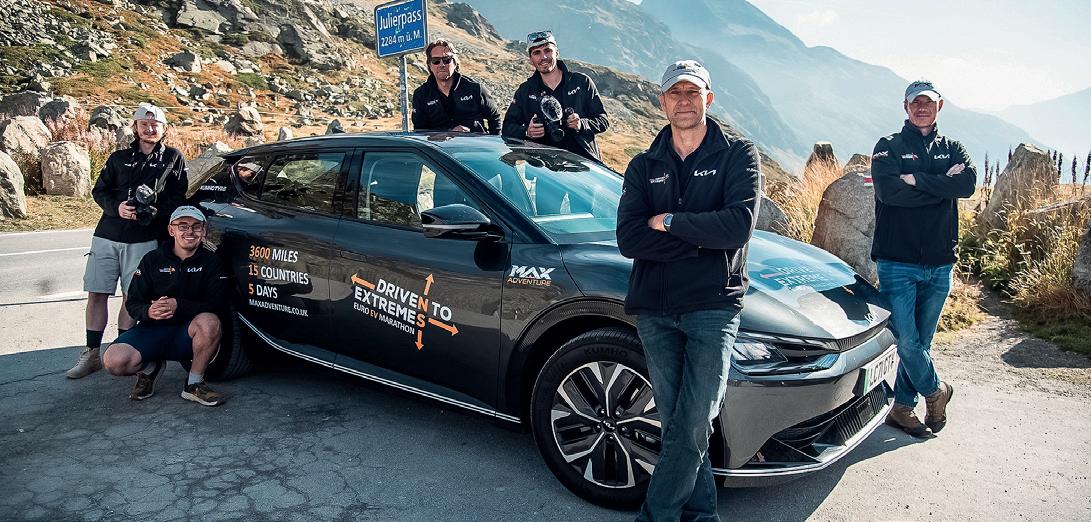
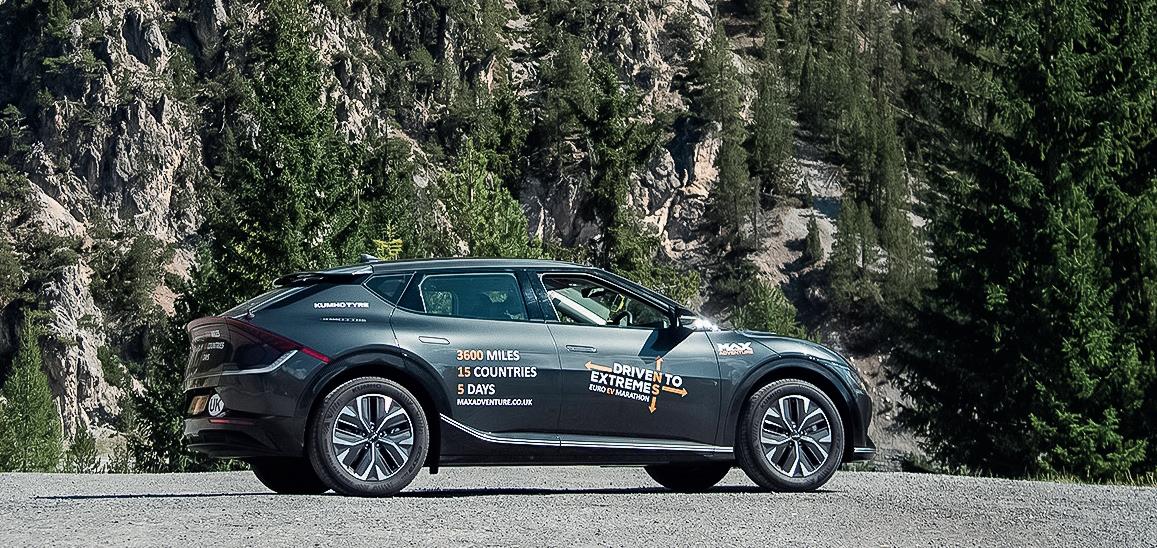
Covering 16 countries and 3,174 miles in a little over 89 hours, the Max Adventure team completed its Euro EV Marathon by driving a fully electric Kia EV6 Air from Oslo to Lisbon back in September.
The team improved on the time set by racing legend Sir Stirling Moss, who undertook the drive in 1952, by 47 minutes. This is understood to be the first time the route has been attempted in a fully electric vehicle. Having completed the epic 3,174-mile adventure, the team arrived in Lisbon to mark World EV Day on September 9th.
Originally intending to cover 15 countries in 120 hours, the team were able to shave more than
a day and add an extra stop to their itinerary after it became clear just how quickly they could cover the distance. Only stopping to charge and change drivers, the team operated in shifts and adhered to the speed limits of each country visited.
Despite recording the journey, the drive wasn’t about setting the fastest time possible, and the team made detours to honour Sir Stirling along the way. This included the 7,500-foot high Julier Pass in the Swiss Alps, part of the original 1952 route, and Monaco, which allowed the team to drive the historic Grand Prix circuit.
Speaking of the challenge, Project Leader Mac Mackenney said: “This wasn’t about trying to beat Sir Stirling, but demonstrate that mammoth trans-continental drives in an EV can easily be undertaken here and now in 2022. Many people still view EVs as ineffective or unable to cope as a daily means of transport outside of city life, but the Kia EV6, and the charging network show that just isn’t true.”
“We’d like to thank Kia UK, as well as Kia Norway and Kia Portugal, for their support and hospitality, and want to recognise the enthusiasm and kindness we’ve experienced on the road as we’ve travelled from the top of Europe to the bottom.”
BI-DIRECTIONAL CHARGINGPART OF THE TOOLBOX
FOR THE ENERGY CRISIS?
BY DANIEL UTGES, HEAD OF PRODUCT - ENERGY - WALLBOX
The current UK power crisis is a complicated mix of several different factors; high gas prices, a structural shift away from ageing fossil fuels to wind dominated renewable energy, and declining French nuclear and EU hydro capacity. Currently electricity forms 20% of all the UK’s energy requirements rising to 78% by 2050. These factors, combined with an economy that is transitioning from the industrial era to the electric era, has resulted in an energy crisis this winter in the UK.
The UK Government has unveiled a raft of proposals to tackle the energy crisis including a focus on domestic energy generation in the future. What has not been discussed is the role of batteries to tackle energy security. This is not just stationary battery assets, including utility scale battery storage systems, but also more flexible and versatile assets such as electric car batteries.
At Wallbox we believe that bi-directional, at home chargers, complemented by sophisticated software that enables customers to be in direct control of their energy consumption, are part of the solution to the energy crisis. Bi-directional chargers will enable EV drivers to be in control of all
their power usage, charging their car when energy is cheaper, during off-peak times and powering their house at times of peak energy prices.
Furthermore, bi-directional, at home charging can save consumers money now. Currently up to 80% of EV charging already happens at home. This is because at home you are in control. You manage your charger, you can control the energy management system, saving you money at a time when energy prices have never been higher.
Consumers that already have solar PV installed at their homes are able to charge their cars with solar energy. In the near future, Wallbox technolo -
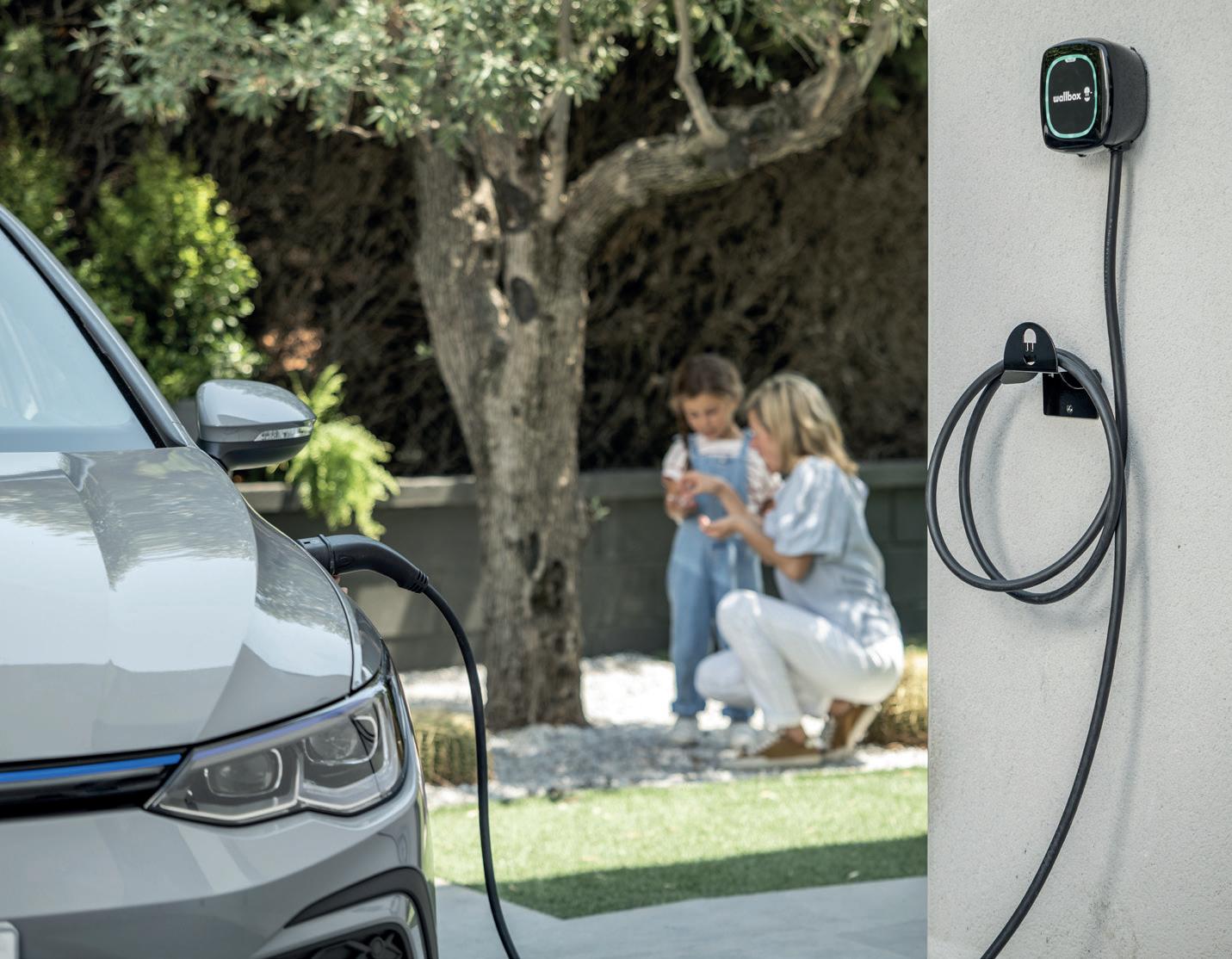
gy will allow users to charge their car for free with solar, and later discharge this energy back to their home when energy prices are higher. This delivers immediate and long term cost savings for the consumer. The car is essentially a battery with wheels. Our vision begins to look more real when we see hundreds of thousands of EV chargers around the world being able to charge and discharge, using our technology, at any point at any time.
If we build on this theme, the average household battery pack is about 7-10kWh of energy capacity. This is typically installed alongside solar PV. A battery in an electric vehicle ranges from 50 to 80kWh. With sophisticated hardware and software technology, such as Wallbox’s, you can utilise the battery that you have already purchased in your car to power your house.
Bi-directional charging is one of the tools that the UK could employ to immediately tackle the energy crisis. It isn’t going to be the only solution, but it is part of a suite of tools that could be used. Looking beyond the immediate crunch this winter, bi-directional will play an even greater role in sustainable energy grids in the UK and globally. Battery assets are expensive to produce, particularly at utility scale. Car batteries, which are Government mandated to be in new vehicles from 2030, are smaller, easier to make, and capable of unloading power into people’s homes rapidly.
The technology is there, the consumer demand is there, and the legislation must follow. At Wallbox we have a charger to meet the needs of every household and we are excited about the future.
The UK is a leading market and what we can all achieve collectively here will be copied the world over as the EV revolution continues at pace.

COLUMN 34
EELO 1885 DISC EXPLORER
PRO REVIEW Richard Alvin shares his views on Eelo’s 1885 folding electric bike...
Mechanical disc brakes have replaced the old bike’s simple V-brakes, while the engine has gained a little oomph and a trigger throttle to aid you getting away from standing starts or give you a boost up hills.
EELO 1885 DISC EXPLORER PRO MOTOR AND BATTERY
Don’t expect a moped-like freewheel from the throttle, it’ll only kick in once the bike senses pedal movement, but the throttle boost is pretty impressive. The simple LCD display gives plenty of information and, unlike a lot of its rivals, the battery level is reasonably accurate without too much in the way of level fluctuation you often find on mid-range systems.
Eelo claims a range of up to 40 miles from the bike’s 280.4Wh battery. That may be achievable if you live in a relatively flat urban area, stay in the most economical of its three power modes and are a smaller, lighter rider.
I couldn’t get much more than half of that range though, because I live in a relatively hilly area and at 6ft2in and 90kg, it takes more energy to move me. My longest run was 22.85miles / 36.77km, with 3,133.2ft / 955m of ascent.
EELO 1885 DISC EXPLORER PRO DIMENSIONS

I wouldn’t criticise the Eelo on range, however, because this is an ultra-compact folding bike. Its 89cm (axle to axle) wheelbase is shorter than a Brompton (105cm) and it’s intended for short-distance rides, commutes or trips to the shops.

Dimensions when folded down are 37x61x59cm, which makes it a good choice to stow in campervans, caravans and boats.
The bike adjusts from a saddle height of 70cm to 98cm (from the floor) and a bar height of 80 to 103cm, making it suitable for riders from under 5ft up to around 6ft 3in. It’s a versatile design that could work for multiple users, perhaps as a single bike for the family or the office to use when needed.
EELO 1885 DISC EXPLORER PRO RIDE IMPRESSIONS
These dimensions, however, come at the expense of the handling. The super-short rear end (36cm) means that taller riders like me are pitched way back over the rear wheel because of the seat angle when the long post is fully extended.
It means the 1885 has a very light and slightly twitchy front end. I adapted fairly quickly riding the Eelo with a pitched-forward seated position. In defense of the 1885, however, my 5ft partner had no issues with the handling on the days she borrowed it for her mixed-mode (bike/train/bike) commute.
The 250w motor contained within the one-piece rear wheel is impressively punchy. The three modes controlling it are at their best when you substitute the assistance for gears, because the 1885 is a singlespeed bike.
On the flat, however, a relatively fit rider will find themselves spinning out the gear all too soon, negating the motor assistance. On hills, the motor provides ample power to assist you smoothly.
The folded bike is suitably compact, though at more than 17kg it’s not exactly light. The fold also doesn’t lock in place properly, like a Brompton, Tern or MiRider.
EELO 1885 DISC EXPLORER PRO BOTTOM LINE
I find it hard to recommend the 1885 to anyone taller than around 5ft 10in, and if you’re in the market for a compact e-folding bike at this sort of price, the MiRider ONE just does things better. Its longer wheelbase and rear make it more stable for taller riders too.
The Eelo isn’t a bad compact folding ebike, it’s just not among the best electric bikes I’ve tested.
35 E-BIKE REVIEW
Eelo’s
1885 folding electric bike has been completely revamped for 2022. The bike now comes with custom onepiece alloy wheels, which look sharp in their raw polished-aluminium state.
Manage your fleet like a master
Your fleet is optimised, you’re on top of regulations, your drivers are happy. You even have enough time for your day job. This is what managing a fleet with Alphabet feels like.
Get everything you need to be at one with your fleet. Welcome to Fleet Dreams.
Alphabet.co.uk/FleetDreams

LOOKING INTO THE FUTURE
Wind Farm boom as UK government to ease restrictions on building onshore farms


OCTOPUS ENERGY partners with Halifax for low-cost heat pump plan
Octopus Energy has partnered with the Lloyds Banking Group with the aim to offer lower cost heat pump installations to homeowners.
Under the partnership, Halifax mortgage customers can apply for a £1,000 ‘cashback’ discount upon installing an air or ground source heat pump.
Octopus Energy said that it was theoretically possible that some homes could install a heat pump for around £2,000 – if the offer is combined with a successful application to the government’s Boiler Upgrade Scheme.

Halifax said that the £1,000 was being provided as part of its ‘Green Living Reward’ initiative and would be open to any of its mortgage customers. The funds will be made available regardless of the heat pump system fitted or installer used.
However, the bank said it has partnered with Octopus Energy to streamline the funding application and installation process.
The energy supplier added that it was confident that it could offer customers an extremely lowcost heat pump installation in line with ambitions to eventually match the typical cost of a UK combi boiler. Earlier this year, the company acquired Northern Ireland-based heat pump maker RED as part of longer-term plans to disrupt the existing heating market.
Octopus Energy said it was currently installing Daikin heat pump systems to homes as a replacement to natural gas boilers. The UK government has committed to ensure at least 600,000 heat pumps are being installed annually across both existing and new build properties from 2028.
Current UK installation rates are thought to be around one tenth of this figure, with around 3,000 heat pumps having been installed via the Boiler upgrade Scheme between May and September.
An estimated 40 per cent of the UK housing stock, expected to account for 10 million homes across the country, are deemed as being particularly suitable for heat pump use, according to Octopus Energy and the Lloyds Banking Group. The project partners

said that this figure could be extended to 14 million homes with the addition of minor efficiency improvements such as installing loft insulation.
Rebecca Dibb-Simkin, chief product officer with Octopus Energy, said that its partnership with Halifax sought to highlight the options available to deliver more affordable low carbon heating systems.
She said: “The pilot with Lloyds Banking Group comes at a crucial time for consumers facing a dual climate and cost of living crisis. It no longer needs to be a question of prioritising one over the other: heat pumps are greener than gas boilers, and thanks to Octopus, the government and Lloyds Banking Group they can be cheaper too.”
A spokesperson for the energy supplier said that it was looking at further collaborations
with banks and financial services groups to look at new ways of financing the installation of sustainable technologies in UK homes. This work has also seen the company partner with NatWest to provide EV chargers.
Jas Singh, chief executive of consumer lending with the Lloyds Banking Group, said it was also looking at methods to help consumers to adopt cleaner domestic technologies for functions such as heat.
Mr Singh said: “Lots of homeowners who need to replace, or want to upgrade, a gas boiler may have considered the switch to a heat pump but see the cost as a barrier. This extension to our Green Living Reward scheme will make switching from a gas boiler to a new, more efficient, cheaper to run heat pump easier and more affordable than ever before.”
NEWS 38
The UK energy supplier will work with the bank to provide a streamlined heat pump funding service that will offer an additional £1,000 discount on top of government low carbon funding.
UK GOVERNMENT to ease ban on onshore wind farms
Prime Minister Rishi Sunak’s government has said it would ease restrictions on building onshore wind farms, heading off a revolt by his party’s who had demanded they should be permitted with local support. Sunak had opposed relaxing the ban on onshore farms in his campaign to become Prime Minister just a few months ago and has said he wanted to focus on offshore wind.
But some in his Conservative Party have been demanding onshore turbines should be allowed where there was local consent, and said they would seek to make changes to a proposed legislation going through parliament.

The government in a statement said it would begin a consultation to see how local
authorities could show local support could be demonstrated.
“Under the proposals, planning permission would be dependent on a project being able to demonstrate local support and appropriately address any impacts identified by the local community,” the statement said.
“Local authorities would also have to demonstrate their support for certain areasa as being suitable for onshore wind, moving away from rigid requirements for sites to be designated in local plans.”
UK CONSULTATION targets improved boiler efficiency standards

The government said the consultation, which would also seek views on whether local communities who backed new projects should get lower energy bills, would start by Christmas and conclude by the end of April next year.
It said certain areas, such as National Parks and Areas of Outstanding Natural Beauty, would still be protected.
The proposals contained within the consultation would apply to all future sales of domestic boilers and be introduced in parallel with efforts to scale up the use of heat pumps and low carbon heat networks.
A major aim of the proposed changes is to ensure all new boilers are not overpowered for domestic
needs and can run at an optimal performance to reduce energy demand in homes. If approved, these reforms would apply to both natural gas and hydrogen systems.
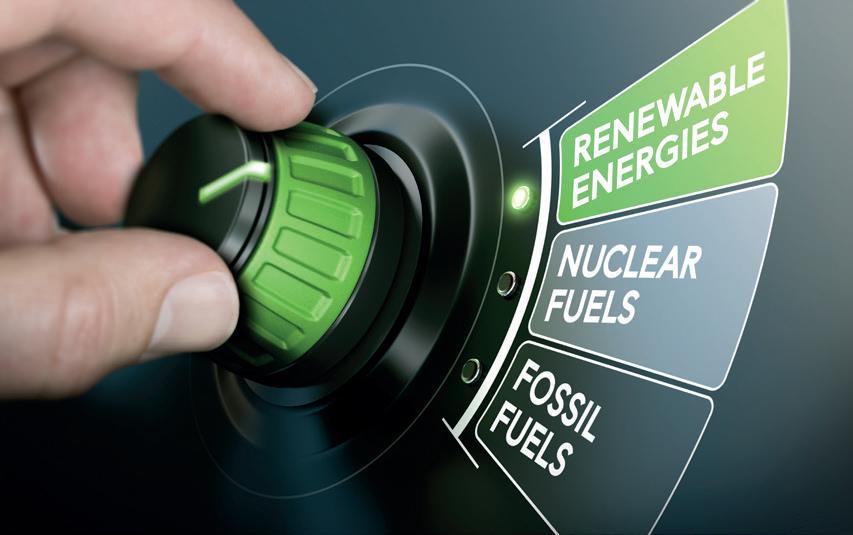
Feedback is being sought for the proposals in the ‘Improving Boiler Standards and Efficiency’ consultation until 21 March 2023. The consultation claims that the proposals could see a six per cent improvement in the in-home performance of new boilers that would be equivalent to a £30 on annual energy bills each year for the average household.

These reform proposals include provisions to revise control requirements for boilers. This would ensure a boiler system is communicating with its controls to modulate heat output and deliver lower flow temperatures.
AIB invests
€8.5
million in solar developer and operator BNRG
AIB has invested €8.5 million in BNRG, an Irish-based developer and operator of solar energy projects globally. BNRG currently has a solar development pipeline of 2.7 GW across Ireland, the USA, UK and Australia, in addition to 23 MW of operating assets in the USA.
Renewable energy will overtake coal by 2025, International Energy Agency predicts
AIB has invested €8.5 million in BNRG, an Irish-based developer and operator of solar energy projects globally. BNRG currently has a solar development pipeline of 2.7 GW across Ireland, the USA, UK and Australia, in addition to 23 MW of operating assets in the USA.
NEWS
BRIEF 39 NEWS
IN
A new government consultation has been launched with the aim to ramp up the efficiency of boilers sold in the UK.
PASSES MAJOR CLEAN AIR REFORMS AHEAD OF COMMONS SCRUTINY HOUSE OF LORDS

Campaigners say plans for sweeping reforms of existing UK air quality legislation have cleared a major landmark after being passed by the House of Lords.

NEWS 40
The Clean Air (Human Rights) Bill would legally require the government to ensure air quality standards are considered across government policy and also mandate stricter monitoring in buildings if passed into law.
It will now be considered for debate by MPs.
The bill has this month completed comprehensive scrutiny by peers, with campaigners arguing that the proposals will serve as a vital new benchmark for standards and how IAQ is being measured and monitored by building operators.
A major focus of the wide-ranging legislation will be to ensure ongoing parliamentary scrutiny of external and internal air quality targets.
It will also outline responsibilities for building operators to monitor and report on the quality of air in their buildings. The changes would apply to both privately owned and public buildings.
Green Party MP Caroline Lucas is now expected to lead the bill through the House of Commons with the aim to gain government or cross party backing to be signed into law.

The proposals were originally introduced to the House of Lords earlier this year by Green Party peer Baroness Jenny Jones as a private members’ bill that enshrines the right to clean air as a priority that must be upheld in the work of all government departments.
The Clean Air in London campaign group, which helped assist with drafting the proposals, said that a number of important provisions were strengthened as the bill passed through the House of Lords.
Simon Birkett, founder and director of Clean Air in London, said the proposals were amended to require that standards should be based on the air quality guidelines set out by the World Health Organisation (WHO). These latest guidelines apply to both indoor and external air quality.

Other notable amendments to the bill were changes to ensure a requirement for monitoring a wider range of pollutants such as ultrafine particles in the air. Levels of Nitrogen dioxide (NO2) within indoor environments are also included in the scope of the bill. These amendments are intended to bring requirements up to date with the latest WHO advice, Mr Birkett added.
The passing of the bill through five stages of scrutiny in the House of Lords has created a new benchmark that can be used to hold policy makers and the building engineering sector against.
Mr Birkett said that both building occupants, as well as facilities managers and other operators
would be able to use the bill to measure the quality of air in a building and call for action where requirements are not met.
This would also help reduce the excuses around a failure to properly ventilate or treat poor quality air, while also tackling concerns about the spread of viruses such as Covid, he said.
If approved, the bill would also ensure that parliament had a continued and important role to scrutinise and update standards in line with any future amendments.
Birkett said this would allow MPs and the Lords to revise requirements or standards in line with any future amendments from the WHO. This would also apply to recommendations from cross-party committees and bodies charged with overseeing environmental policy.
He said: “That is a proper democratic way for tightening the standards if needed.”
A function of the bill would be to introduce an annual review process to be overseen by the Climate Change Committee. This process would also be backed by a new independent body known as the Citizen’s Commission for Clean Air that would be formed under the current bill and given powers to enforce the legal requirement of the right to breathe clean air.
Birkett concluded: “If they recommended tightening standards, they would only be implemented if approved by both houses of parliament.”
Any plans to introduce these requirements would be dependent on the bill being approved by the House of Commons and passed into law.
If there is insufficient backing from the legislation during the current parliament to pass the legislation, campaigners are hoping to see parties include plans for the Clean Air (Human Rights) Bill in future party manifestos.
‘ELLA’S LAW’
The Clean Air (Human Rights) Bill is also known as ‘Ella’s law’. The name relates to Ella Roberta Kissi-Debrah, a British schoolgirl who died in 2013. A coroner ruled in 2020 that air pollution had directly contributed to the schoolgirl’s death.
A year later, the coroner said the government should look to introduce stricter standards for acceptable levels of airborne contaminants in line with changes set out by the WHO to its air quality guidelines.
Ella’s mother, Rosamund Adoo Kissi-Debrah, has been campaigning to enshrine access to clean air as a human right under international law.

41 NEWS
This would also help reduce the excuses around a failure to properly ventilate or treat poor quality air, while also tackling concerns about the spread of viruses such as Covid. ”
“
HYDROGENOR HEAT PUMPS:


HEATING YOUR HOME 42
How will we heat our homes in the future?
The neighbourhood is one of two sites, the other being Redcar in North Yorkshire, which the government may select next year to become the country’s first “hydrogen village”.
If Whitby is selected, then Cadent, the gas distribution network that would be running the trial, will offer residents a choice of replacing their gas boiler either with one that runs on hydrogen, or with a heat pump. Cadent would pay for either, but after it has repurposed the neighbourhood’s pipes to deliver hydrogen, residents would not be able to return to gas.
The trial will inform the government’s decision, in 2026, as to whether hydrogen, which releases no carbon dioxide when burnt, will have a substantial role in reducing the greenhouse gas emissions that come from heating the country’s homes. Those emissions account for about 14 per cent of the country’s total — thanks to our 23 million gas boilers.

Under government plans, no homes will be built with gas boilers from 2025, and their sale will be banned from 2035. But if domestic heating is to be decarbonised, it won’t be enough merely to stop gas boilers being installed. We’ll also have to replace those we already use.
But what will we replace them with? Would it be economical and practical to deliver hydrogen through the existing gas network? Or could we rely on heat pumps and electric boilers to do the job instead?
These are questions that residents of Whitby find themselves unexpectedly having to ponder. Since the beginning of the trial, more than 900 residents have joined a Facebook group where they share experts’ opinions on the future of home heating.

The group was set up by Kate Grannell, a resident, who believed Cadent, with its vested interest in maintaining the use of its pipes, was manipulating her community into choosing hydrogen over heat pumps. She was initially in favour of the trial, thinking “that sounds great, I want to help fix the planet”, but now believes that the two Cadent employees who told her about the merits of hydrogen “sold it to me on a dream and a whim”.
She worries that Cadent might be leading her community up a dead end, towards a technology that heat pumps could render superfluous.
Yet Cadent’s director of strategy Angela Needle thinks it would be a mistake to pit one technology against the other. She sees them as “complementary”, and expects heat pumps to be “the dominant technology”, servicing new-builds and spacious, well-insulated houses.
She also asserts that not all homes will be suitable for heat pumps, because “they take up quite a bit of space”, while adding that they are expensive — an air source pump costs between £7,000 and £13,000, according to the website heatpumpchooser.com — whereas boiler manufacturers have pledged that hydrogen boilers will be no more expensive than the ones currently in use. She also says that installing a heat pump is often more inconvenient than swapping a natural gas one for a hydrogen boiler, because “you might have to get new radiators”.
43 HEATING YOUR HOME
In the neighbourhood of Whitby in Ellesmere Port, Cheshire, residents are grappling with a question that many more of us will have to ask in the coming years: how should we heat our homes if we’re no longer allowed gas boilers?
For these reasons, Needle expects that “between 30 and 50 per cent” of homes will be heated by hydrogen in the decades to come, compared with 80 per cent now heated by gas. It’s not that it would be impossible to install heat pumps in these smaller, less well-insulated homes, she argues, it’s just that it might not be economical to do so.

Needle’s estimate is roughly in line with a report produced by researchers at Leeds Beckett University in partnership with the Energy and Utilities Alliance, a trade association of which Cadent is a part. The report found that only seven to ten million British homes are suitable for heat pumps, while three to four million could be made so with improvements such as cavity wall insulation. It found that between eight and 12 million homes were rendered unsuitable by “a lack of exterior space and/or the thermal properties of the building fabric”.
The report found a variety of types and ages of property were unsuitable for heat pumps, including prewar terraces and flats. These findings are substantially more pessimistic than those of a government-backed study published last December, which found that all housing types are suitable for heat pumps, including Victorian terraces and prewar semis.
It is one of many recent studies that have suggested hydrogen might play a minor role in heating, if any at all. This month the International Energy Agency said it expected the fuel to play a “negligible” role.
This was also the conclusion the energy researcher Jan Rosenow came to, after reviewing all 32 independent studies of heating homes with hydrogen. “Not a single one of them says hydrogen is going to be cheaper and more cost-effective than deploying the other solutions, like heat pumps and district heating,” Rosenow says.
One of these studies showed that by 2050 hydrogen boilers could be between two and three times more expensive to run than heat pumps, which are already cheaper to run than boilers thanks to this year’s increased gas prices.
Rosenow explains that hydrogen boilers will always cost more to run than heat pumps because they are less efficient. The only carbon-free way to make hydrogen is to run a renewably generated current through water, a process that produces about 0.7 units of hydrogen energy for every one unit of electricity.
Heat pumps, by contrast, produce between three and four units of heat for every one unit of electricity. This means that the same amount of electricity can generate about five times as much heat via a heat pump as via the production and combustion of hydrogen. together and go with heat pumps.”

HEATING YOUR HOME 44


45 HEATING YOUR HOME
”
What the future looks like, in my view, is a number of years of confusion and a lot of silliness, and then finally we’ll get our act together and go with heat pumps.
“
TRAINING FOR THE FUTURE
The site is currently scheduled to open in the spring and marks a partnership between training specialists Quantum Group, the Centre of Engineering and Manufacturing Excellence (CEME), and manufacturer Daikin UK.
Among the main aims of the new Centre of Excellence project will be to provide the opportunity for existing plumbing and heating engineers to diversify into providing heat pumps as a lower carbon alternative to natural gas boilers.
Installers trained at the centre will also be given ongoing assistance from Daikin UK on the safe and effective installation of its heat pump systems across the country.
The UK Government has set a target for 600,000 heat pumps to be installed annually from 2028 as part of broader aims to gradually wean the country of natural gas boilers over the next decade and a half.
Initiatives such as the Boiler Upgrade Scheme incentive, launched this year, and other funding programmes such as the Social Housing Decarbonisation Fund (SHDF) are intended to help offset upfront cost barriers to scaling up heat pump use.

The government has also cited the planned introduction of the Future Homes Standard in 2025 as another important measure to help build the market for low carbon heat.

The standard will seek to outlaw the installation of natural gas boilers in new homes in order to drive up demand for heat pumps.
Martin Passingham, product and training manager with Daikin UK, said that it was increasingly important for heating engineers to have the right skills to provide low carbon systems with the planned introduction of the Future Homes Standard in just over two years.
He said: “With gas boilers being banned in new homes from 2025, and incentives in place to ensure the country’s existing housing stock is upgraded to low carbon heating, household demand for alternatives like heat pumps is stronger than ever.”
HEATING YOUR HOME 46
A new heat pump training centre set to open in Essex in 2023 aims to create 2,000 additional installers each year.
Government hands out First Green Heat Network Fund awards for cutting-edge low carbon energy projects
Projects in Hull and Peterborough are the first to secure funding through the Green Heat Network Fund (GHNF), a £288 million government funding scheme launched in March this year.

Heat networks offer carbon emissions savings by supplying heat to buildings from a central source, avoiding the need for households and workplaces to rely on individual, energy-intensive heating solutions - such as gas boilers. As such, heat networks provide a significant contribution to the UK’s carbon reduction commitment.
The two cities will receive more than £27 million from the total funding allocation, to support initiatives that deliver clean heating to households, offices, commercial and public buildings, reducing energy bills and carbon emissions at the same time.
The GHNF funding will pave the way for low carbon technologieslike heat pumps, solar and geothermal energy - to be delivered at scale and established as a central heating source. The scheme is expected to reduce emissions equivalent to taking 5.6 million cars off the road for a year.
Meanwhile, in Wigan more than £2.6 million has been made available through one of the final awards from the £320 million Heat Networks Investment Project, which was succeeded by the GHNF this year after running since 2018.
Energy Minister Lord Callanan said: It’s vital that we invest in cutting edge technologies, like heat networks, that move us away from heating our homes and businesses with carbon-emitting fossil fuels.
I’m delighted to see that, through the Green Heat Network Fund, ground-breaking projects will be developed at pace to the benefit of communities, moving us away from soaring energy bills and delivering cheaper, greener energy.

Ken Hunnisett, Programme Director for Triple Point Heat Networks Investment Management, delivery partner for the GHNF and HNIP, said: It will be such a pleasure to work with the teams in Hull and Peterborough to deliver these fantastic, real-world, clean energy infrastructure projects that will generate local jobs and provide heat to local communities, all during the life of the Green Heat Network Fund.
Such has been the pace at which the new fund has launched that we are still announcing the late-stage successes of its predecessor, the Heat Network Investment Project. The new network at the heart of the redeveloped Galleries Shopping Centre in Wigan will be delivering low carbon heat to retail, leisure, and residential premises within the next 3 years.
In a further boost to future investment in low carbon heat networks, councils will now be offered streamlined access to the UK Infrastructure Bank’s £4 billion local authority lending product as part of the GHNF application process.
John Flint, CEO of UK Infrastructure Bank, said: With rising energy bills, the need for low cost, low carbon heating systems is clear. Heat networks provide an innovative and proven solution which can help tackle the net zero and local growth challenge. Helping local authorities unlock access to finance for these projects will be crucial.
The Bank is well placed to play a significant role in supporting the development of heat networks and we are pleased to be taking the next step through our new partnership with BEIS in fulfilment of this ambition.
47
LOW CARBON
More than £30 million of funding will benefit homes and businesses in three communities to deliver low carbon heat and help consumers move away from costly fossil fuels as part of the government’s push to cut emissions.
CAN SOLAR POWER INCREASE YOUR COMMERCIAL PROPERTY VALUE?
One way that is gaining in popularity is through the installation of solar power systems. While there are initial costs associated with installing a solar power system, over time these systems can provide a significant return on investment.
Whilst it’s easy to list the many benefits of commercial solar energy for businesses, pinpointing their value can be more complicated. The impact on property value is one such example.

Although high-quality solar panels for commercial buildings make the properties more valuable than those powered by fossil fuels, it can be tough to calculate exactly how much extra value they add. If your organization is looking to commercial solar panels to increase property value, this article may be of help.
First, let’s look at solar installations for regular homes, not businesses. One study found that homes with solar panels sell for 4.1% more than similar homes without them. Some reports say that businesses with solar power increase in value too, but we need more studies to be sure. The main idea is that adding solar power could
make a property worth more money. Let’s try and answer a few common questions to get closer to our main objective.
Is the organization that is installing solar power the owner of the building?
The adopting organization reaps the most benefits when it owns both the site and equipment being installed. With ownership comes access to any possible tax incentives, as well as reduced energy expenses and potential for claiming renewable energy credits (promoting the solar system’s green attributes in turn). Lastly, commercial property value usually increases.

What are the benefits of commercial solar for a leased property?
Even though renting their commercial facilities, many organizations can still benefit. Most of the property-related costs (e.g., insurance, property tax, utilities) are paid for by the lessee (or passed on to them in the form of higher rent). By installing commercial solar panels, they could reduce the energy expenses shouldered by the lessee—
COMMERCIAL PROPERTY 48
Commercial property owners are always looking for ways to increase the value of their investments.
and enjoy public perception boosts that come with having solar power visible at their site.
Is the organization that is installing solar power the owner of the building?
Here are few advantages that renters can bring up when trying to convince a landlord to install commercial solar:
• Reduced energy bills – Solar panels can provide significant savings on electric bills, especially in states with high electricity rates.
• Solar credits and incentives – Many utilities offer financial incentives for installing solar panel systems, which can help offset the upfront cost of installation.
• Environmental impact – Reducing your carbon footprint is important to many people today, and using renewable energy sources like solar power helps do that.
• Increased property value – Solar installations have been shown to increase the resale value of properties, so it’s something that landlords should keep in mind as well.
Can solar panels increase your home’s resale value, even if indirectly?
A less clear but still vital factor is that having solar panels sends a message of being eco-conscious, socially responsible and forward-thinking.
Aside from enhancing your public image, commercial solar systems provide the advantages and cost savings that come with going green, as well as modernizing a building’s exterior. In most cases, properties that look nicer are worth more money.
Co-relations between Property Value and Installing Solar Energy in Commercial Premises

1. Solar energy installation has a positive effect on commercial property values.
2. The increase in value is greatest for small businesses and decreases as business size increases.
3. The value of the property also affects the amount of the increase.
4. Newer properties see a greater increase than older properties.
5. The location of the property also plays a role, with properties in sunnier locations seeing a greater increase than those in shadier locations.
6. Solar energy installations have a positive effect on both lease rates and occupancy rates for commercial properties.
7. The installation of solar energy systems can help to attract and retain tenants, as well as improve the marketability of the property.
8. Solar energy installations can also help to reduce operating costs for commercial properties, resulting in increased profitability.
9. Solar energy is a sound investment for commercial property owners, with returns typically exceeding the cost of installation within 5-10 years.
10. Commercial property owners who install solar energy systems often see an immediate increase in their property’s value.
There are plenty of reasons why commercial property owners should consider installing solar energy systems. Not only can they save money on energy costs, but they can also increase the value of their property and attract new tenants.

The installation of solar energy systems has a positive effect on the environment and sends a message of social responsibility to the public. For all these reasons, it is a wise investment for businesses of any size.

Making the switch to solar can be intimidating at first, but with careful research and understanding of the benefits, it’s one of the most rewarding investments that business owners can make. From reducing energy costs to increasing property value, it’s a great way to go green and reap the rewards. It’s no wonder why more and more business owners are making the switch to solar power!
Businesses should carefully research and understand the financial incentives, credits, grants, and other benefits offered by their local government. Additionally, they should factor in the cost of installation, size of the system, amount of electricity generated, and estimated energy savings over time.
As solar panels are designed to be low-maintenance and typically only require inspections every five years or so. Additionally, depending on the type of system installed, many components come with warranties that last up to 25 years or more!
49 COMMERCIAL PROPERTY
WHAT IS SMART CHARGINGAND WHAT ARE THE BENEFITS FOR YOU?

All
In essence, chargers like these allow you to manage your car’s charging habits efficiently, with the added benefit of potentially cutting your energy bills. In the longer term, smart-charging technology will in theory allow electric-car owners to profit from the energy stored in their batteries by selling it back to their energy provider at times of peak demand or low production. Allow us to explain...
So how does smart charging work?
The UK government defines smart charging as “shifting the time of day when an EV charges, or modulating the rate of charge at different times, in response to signals (e.g. electricity tariff information)”.
In simple terms, smart chargers work using a live data connection to your car and the wallbox itself, as well as a live data connection to your electricity tariff provider. This allows the car – or rather its driver, typically using an app – to tell the charger what capacity you want your battery topped up to and by what time, each time the car is plugged in. So, you can instruct the smart charger to ‘fill ‘er up’ to 80% by 7am before you set off on your regular commute, or inform it that you only need a 60% charge by 8.20am, because you’re only doing the school run tomorrow and working from home. What’s more, because the smart charger knows your energy tariff’s rates, it can deliver just the right amount of charge to your vehicle at the cheapest time. This is particularly handy if you have a dual-rate tariff, like those from Octopus Energy or British Gas. Some smart chargers work from basic tariff information entered by the user, while other more advanced units can sync automatically with your energy tariff. Either way, it’s
a more efficient way to charge than simply plugging in when you get home.
The other side of the coin is that energy providers can alter the rate and times at which your smart charger works, to suit the changing energy levels in the power grid and help to smooth out spikes and troughs in demand. However, this will never override the essential parameters you set or leave you without juice when you need it.

Although the name is similar, the smart-charger concept is therefore a bit different to the smart electricity meters that have been fitted to houses and businesses in the UK in recent years, which simply track your usage. To save on your household bill, you need to actively change your habits or usage patterns based on the information a smart meter provides, whereas a smart charger
makes the decisions for you.
Depending on which charger you choose, and your electricity provider, you can even instruct your smart charger to pick the most environmentally friendly time to charge, instead of the cheapest. For example, by specifying those times when the national grid’s green-energy producers are working at their hardest relative to fossil-fuel stations.
Why is a smart-charger rollout considered essential at a national level?
A trial in 2021 that monitored the charging habits of almost 700 drivers highlighted the potential problems that millions of electric cars on our roads could cause for the national grid. Shared work and commuting habits create peaks of demand when everyone plugs in their charger
SMART CHARGING 50
domestic electric-car charging points sold in the UK from June this year are what’s referred to as ‘smart chargers’. But saying a home wallbox has smart functionality doesn’t mean a lot on its own, so we decided to break down exactly what these capabilities are – and what benefits EV owners get from having a smart charger.
SMART CHARGING
at once – for example, after getting home from work on a Friday. With ‘only’ around half a million electric cars currently on the road in the UK, those spikes in demand can be managed, however, it’ll be a very different story when the number of electric vehicles on our roads reaches into the millions as we approach the 2030 ban on the sale of new petrol and diesel cars.
Of course, while all those drivers may plug in at once, the chances are they’ll be connected to their chargers for many hours longer than they need to take on the required amount of charge. The idea is that smart chargers communicating with power providers will be able to help even out the peak in demand accordingly.
Another major issue that smart meters address is the production and storage of energy in a ze-


ro-carbon economy. Currently, if there’s a surge in demand for electricity, the national grid can fire up a fossil-fuel generator to cover the spike. But as the UK must rely increasingly on renewable energy sources for electricity generation, what happens if the wind drops and the turbine blades slow or stop turning?
The answer, it’s believed, will be the electricity stored in the millions of parked electric cars with their batteries connected through smart chargers to the grid. New ‘vehicle-to-grid’ (V2G) technology that’s beginning to be implemented will allow smart chargers to momentarily feed power back to the grid, smoothing out troughs in supply or responding to peaks in demand when it’s no longer possible to shovel coal into a generator furnace.
How much cash can you save with a smart charger right now?
Many of the future advantages of smart chargers – especially the V2G element – are not yet sufficiently developed to be rolled out. Although plenty of companies have run successful trials, only a very small selection of electric cars have the necessary vehicle-to-grid charging capabilities. It’ll likely require some sort of concerted government or legislative effort to make things happen.
However, while you can’t yet sell juice back to your energy company, there’s every reason to take advantage of smart charging now. Estimates suggest electric-car drivers could save an average of between £200 and £250 yearly on their charging costs by ensuring they only charge ‘smartly’ at peak times.
51
How to choose a new renewable energy supplier
Renewable energy, also known as green energy, is energy that replenishes itself from nature, through clean sources that are more sustainable and better for the environment – such as solar, tidal or wind.
If you’re interested in renewable energy, you can look for a ‘green’ tariff or a ‘green supply tariff’. This refers to suppliers’ tariffs that will match your energy usage by giving back an equivalent in renewable energy to the National Grid.


Why should I choose green energy?
Standard energy, sometimes referred to as ‘brown energy’, comes from fossil fuels that release carbon dioxide into the atmosphere, contributing to global warming. With climate change increasingly important to environmentally conscious consumers, many people are considering how they can limit their carbon footprint. ‘Going green’ with your energy can help the environment, since renewable energy is pumped back into the National Grid.
However, there’s been some press coverage about green energy providers and green tariffs not always being exactly what they seem. Con-
sumers have criticised the labelling of green tariffs for being confusing. It’s worth noting that even electricity generated from renewable sources has some impact on the environment – think of the manufacture, installation, and operation of the equipment, for instance. To that end, some companies also give details of the overall carbon content of their electricity, in a bid to be more transparent.
You don’t have to get all your energy from renewable sources. You could compromise and find a supplier that supports environmental projects or sources just some of its energy from renewables, or funds other carbon-offset schemes. Alternatively, you could make your own renewable electricity by having solar panels installed.
How do I compare renewable energy?
Some suppliers can offer up to 100% green energy. If they offer a mix of energy (some renewable and the rest from traditional sources), they have to be upfront about the percentage mix so you know exactly what you’re getting.
There are two main types of green tariff: Green supply tariffs – suppliers will match your energy usage by giving back an equivalent in renewables to the National Grid.
Green funds – with these tariffs, you pay a premium and the supplier donates to support renewable energy projects.
RENEWABLE ENERGY 52







































































































































